Eating South Korean food in the capital city of Seoul was a game-changer.
I’ve been exposed to Korean food since childhood but my experience was limited to the most popular Korean dishes. Before our trips to Korea, all I knew about were bulgogi, galbi, and jap chae. That was it.
Visiting Seoul opened my eyes to a new dimension of Korean cuisine. It was like opening door number two and discovering new and delicious dishes like jokbal, gyeranppang, and ganjang gejang. I was intrigued and excited and curious to try as many Korean foods as I could.
We’ve been to Korea three times in over four years and have tried many tasty Korean dishes, the best and most interesting of which are listed in this South Korean food guide.
If you’re visiting South Korea and want to experience as wide a range of Korean food as possible, then this article will be very useful to you.
KOREAN FOOD QUICK LINKS
If you’re planning a trip to South Korea and want to really dive into the cuisine, then you may be interested in joining a food tour or taking a cooking class.
TOURS & OTHER SERVICES
- Food Tours: Food Tours in South Korea
- Cooking Classes: Cooking Classes in South Korea
- eSIM: South Korea eSIM
Save This on Pinterest!
No time to read this South Korean food guide now? Click on the save button and pin it for later!
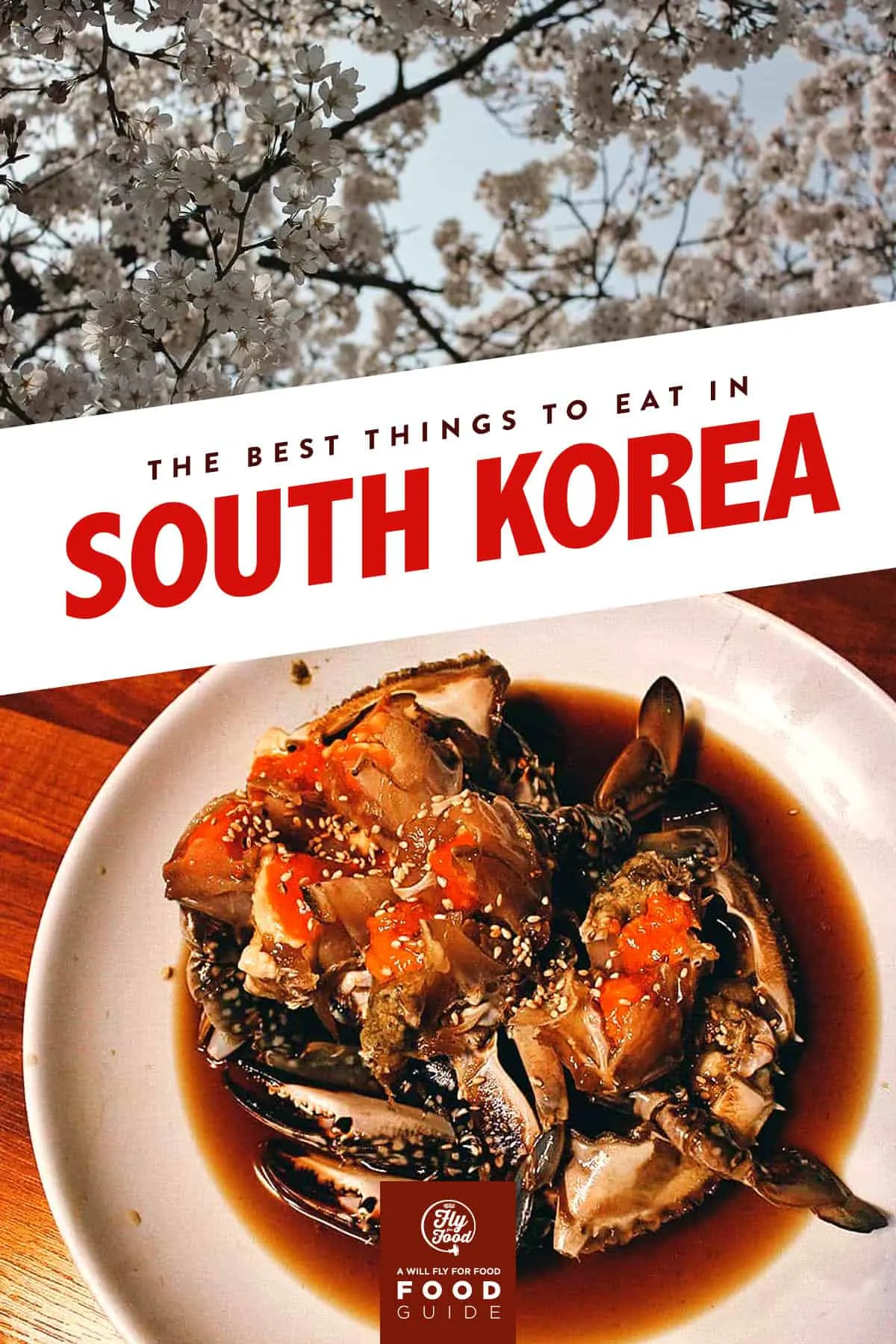
WHAT IS KOREAN FOOD?
Rice, vegetable, and meat dishes feature prominently in Korean cuisine. Traditional Korean meals are preceded by a number of small side dishes called banchan and kimchi is served at almost every meal.
Because of Korea’s geographic location in northeast Asia, it experiences four distinct seasons – spring, summer, autumn, and winter. This seasonality plays a significant role in the local cuisine. Some ingredients taste differently each season, resulting in a variety of flavor variation within recipes.
Commonly used ingredients in South Korean food include sesame oil, soy sauce, ginger, garlic, gochujang (fermented red chili paste), gochugaru (pepper flakes), doenjang (fermented bean paste), and napa cabbage.
Grains and legumes are an important part of the Korean diet which puts an emphasis on variety and moderation. Many different types of vegetables are used in Korean cooking while beef, chicken, and pork are the proteins of choice.
Because the Korean peninsula is bordered by the Yellow Sea, the East China Sea, and the East Sea (Sea of Japan), fish and shellfish also feature prominently in the cuisine.
THE BEST KOREAN DISHES
To help organize this Korean food guide, I’ve divided it into three categories – traditional restaurant food, street food, and trendy snacks.
Restaurant food represents traditional Korean dishes you’ll typically need to order at a sit-down restaurant. Street food are dishes often sold by sidewalk vendors while trendy food describes snacks that may be little more than a passing fad. By that, I mean they could be all the rage one year then virtually gone the next.
KOREAN RESTAURANT FOOD
1. Banchan
Banchan is the collective term for the family of small side dishes served with kimchi stew at the start of a traditional Korean meal. I like to think of them as the Korean version of Spanish tapas.
They’re served in small portions and typically consist of fermented, steamed, marinated, or stir-fried vegetables, though some dishes may contain some meat or seafood as well.
The number of banchan served usually increases with the formality of the meal. They’re meant to be consumed with your meal and are usually replenished if the amount served isn’t enough.
RECIPE: Korean side dishes (banchan)
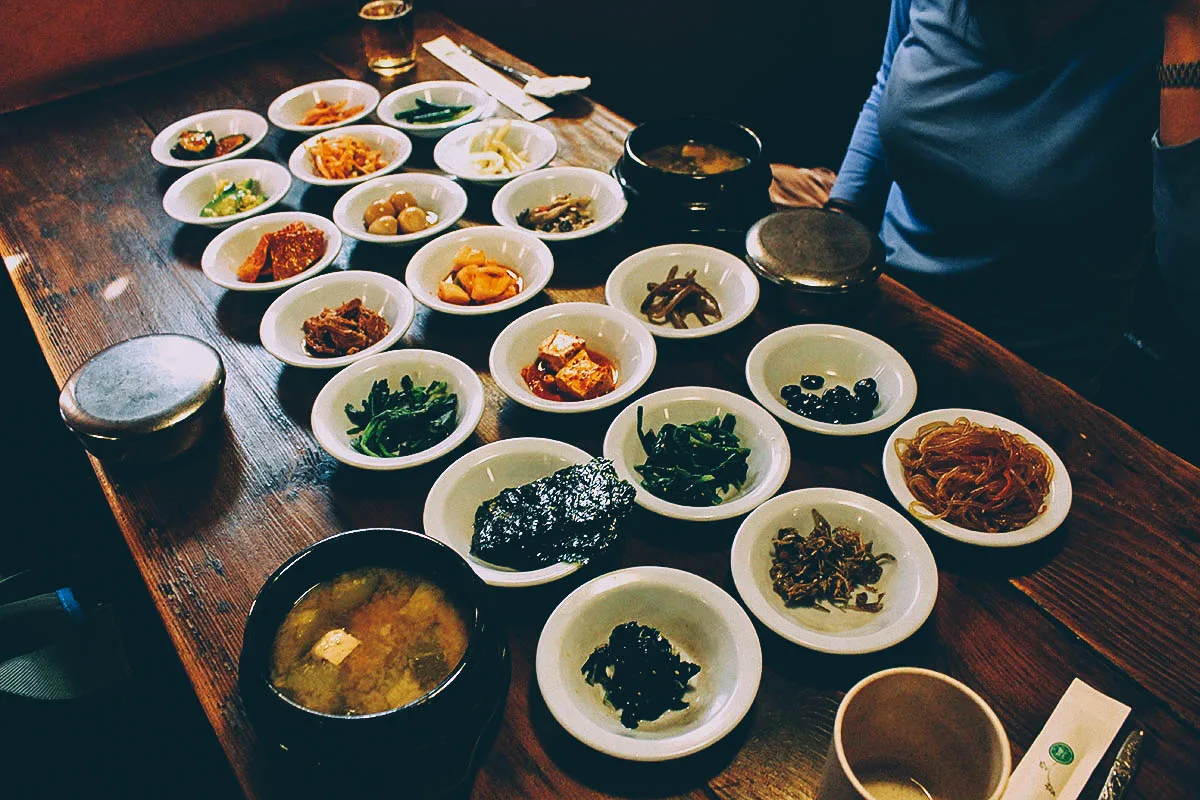
2. Bibimbap
Bibimbap is one of the most popular South Korean foods. It literally means “mixed rice” and refers to a Korean rice dish made with warm white rice topped with gochujang, doenjang, soy sauce, and a variety of sauteed and seasoned vegetables like cucumber, soy bean sprouts, radish, spinach, and mushroom.
A raw or fried egg and sliced meat, typically beef, are often added. The contents are then mixed together thoroughly before being eaten.
You can find different variations of this mixed rice dish in Korea, some of the most popular being Jeonju bibimbap, dolsot bibimbap, and Yakcho bibimbap.
RECIPE: Bibimbap
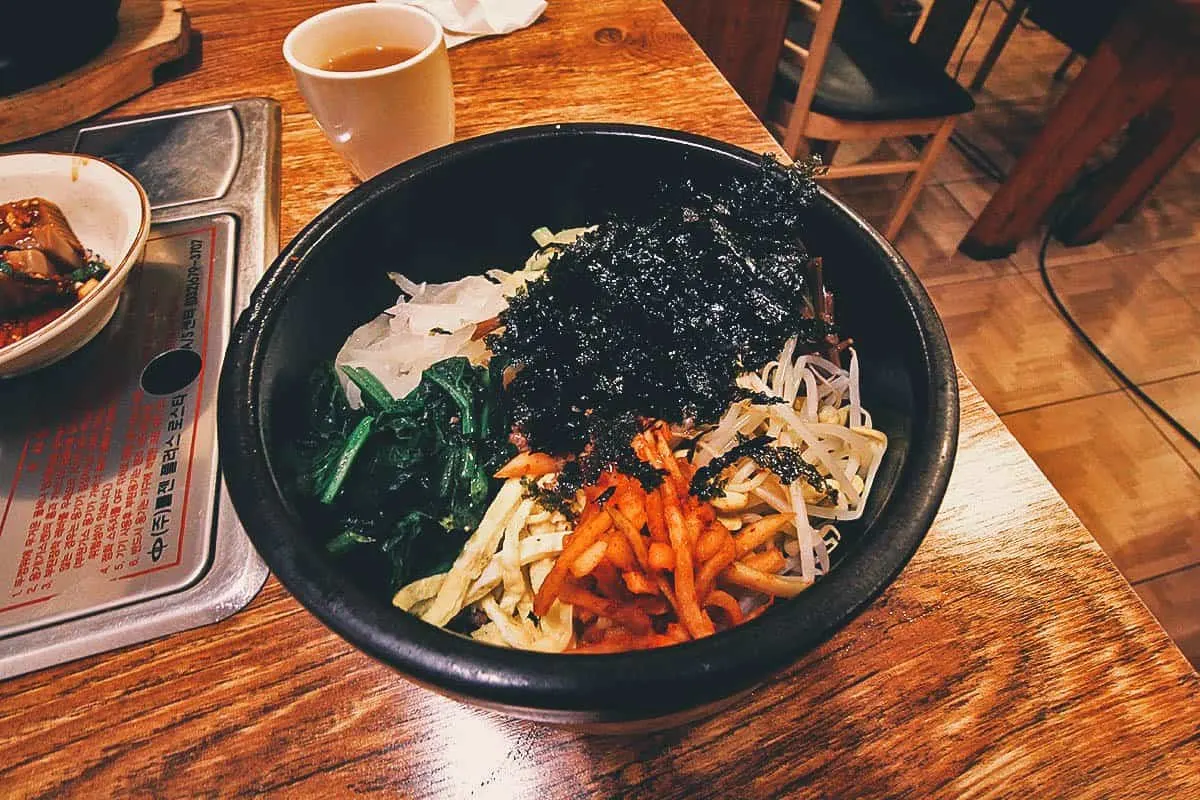
3. Bingsu
Bingsu is a popular South Korean shaved ice dessert. Looking at it, you’d think it’s a recent creation but records show that its earliest forms have existed since the Joseon Dysnasty.
At its core, bingsu consists of shaved ice topped with an endless variety of ingredients like red bean, chopped fruit, green tea, chocolate, and other sweets.
The most traditional versions always contain red bean and are known as patbingsu. Bingsu refers to more modern versions made without red bean.
RECIPE: Injeolmi bingsu
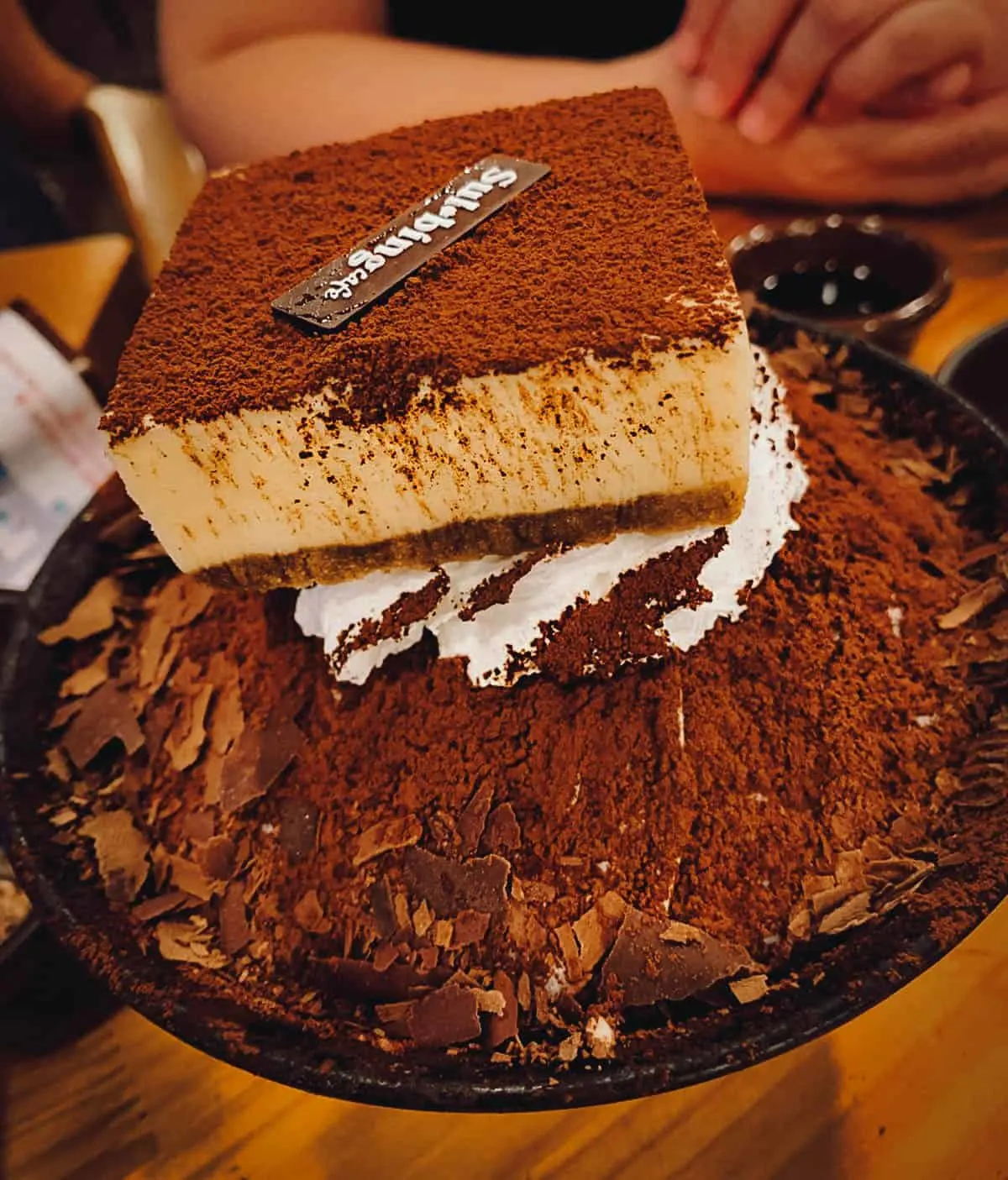
4. Bossam
Bossam refers to a Korean pork dish made with thinly sliced pork boiled in a broth with spices like star anise, ginger, scallion, garlic, doenjang, and soybean paste. Pork shoulder is the cut of choice though pork belly can also be used.
Bossam is served with a variety of sides like sliced raw garlic, kimchi, and saeujeot (salted shrimp). It’s a type of ssam dish, meaning the pork and sides are wrapped together in vegetables like lettuce or perilla leaves before being eaten. Bossam literally means “wrapped” or “packaged”.
Bossam is a popular anju dish, meaning it’s a South Korean food typically consumed with alcohol like soju or beer.
Pictured below is a combination platter of bossam and jokbal from the Manjok Ohyang Jokbal restaurant in Seoul. The paler cuts of meat on the right side of the plate is the bossam.
RECIPE: Bossam
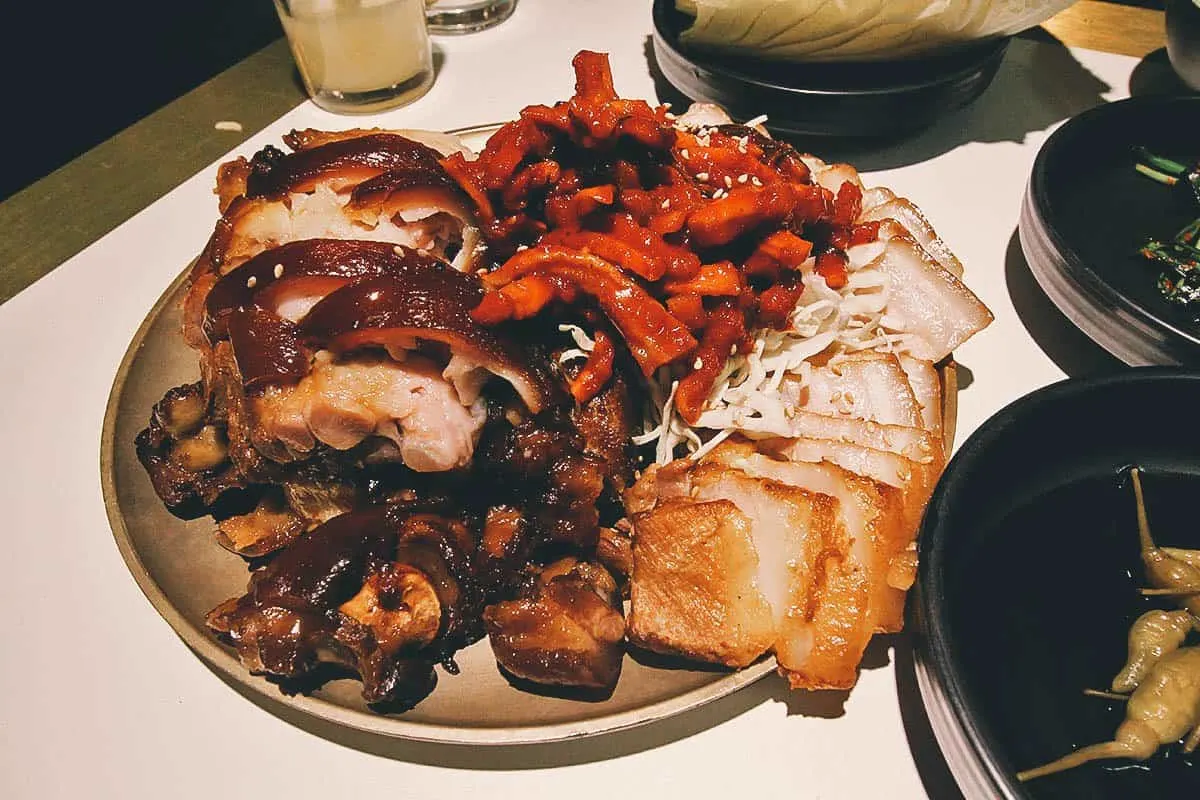
5. Chimaek (Korean Fried Chicken & Beer)
Chimaek is a compound word for chi-cken and maek-ju, the Korean word for “beer”. It’s another popular anju dish that refers to the duo of Korean fried chicken and beer.
Fried chicken dishes became a popular food in Korea around the mid to late 20th century. It was around that time that a new draft beer was also gaining popularity so it became common to combine the two as a single menu item.
Today, fried chicken is one of the most popular foods in Korea, with the term chimaek being coined during the 2002 Korea–Japan World Cup. What makes Korean fried chicken so good is that it’s double-fried, resulting in crunchier and less greasy skin.
Chimaek is a combination that’s become ultra-popular not just in Korea but in many other parts of the world as well, thanks to international chains like Bonchon Chicken.
RECIPE: Korean fried chicken
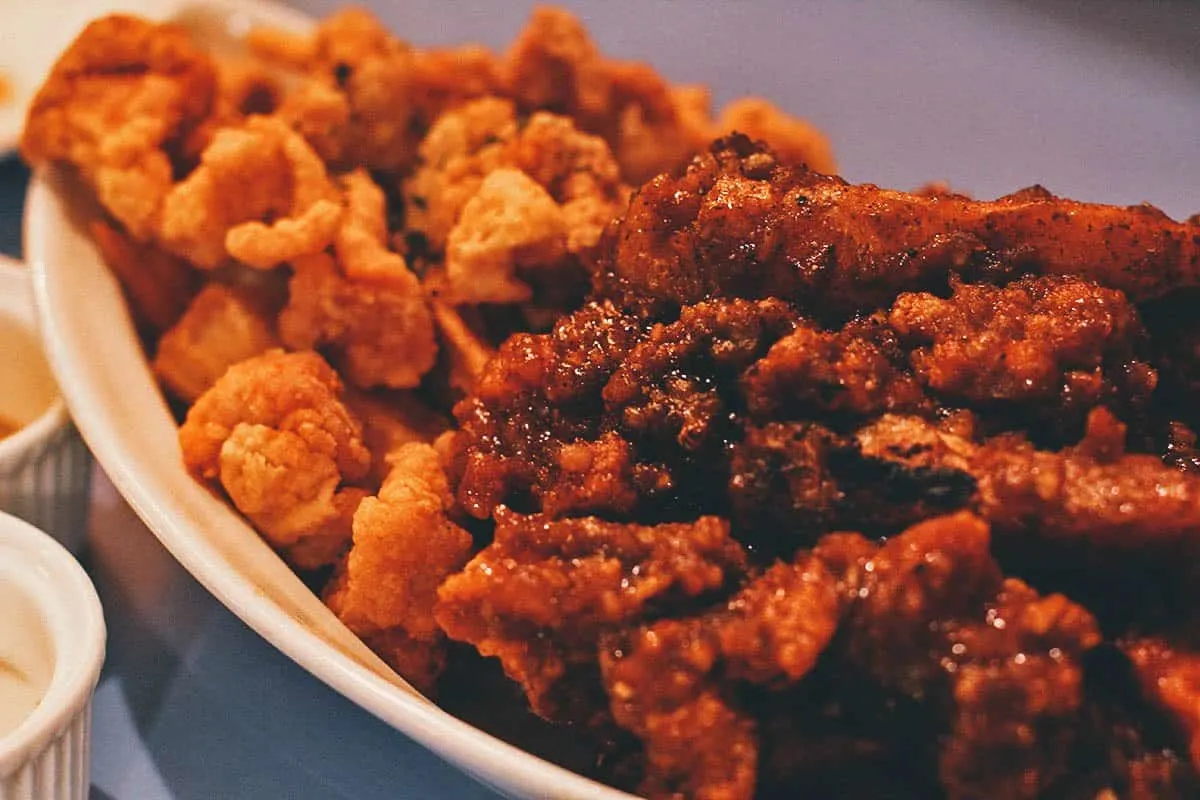
6. Chueotang
Chueotang refers to a soup made from pond loach, a type of freshwater mudfish. The fish is boiled in water until tender, then sieved to remove all its bones and skin.
The fish meat is boiled again with beef or chicken broth and seasoned with gochujang, doenjang, grated ginger, and ground black pepper before being served in a soup with vegetables, mushroom, fried tofu, rice, and noodles.
RECIPE: Chueotang
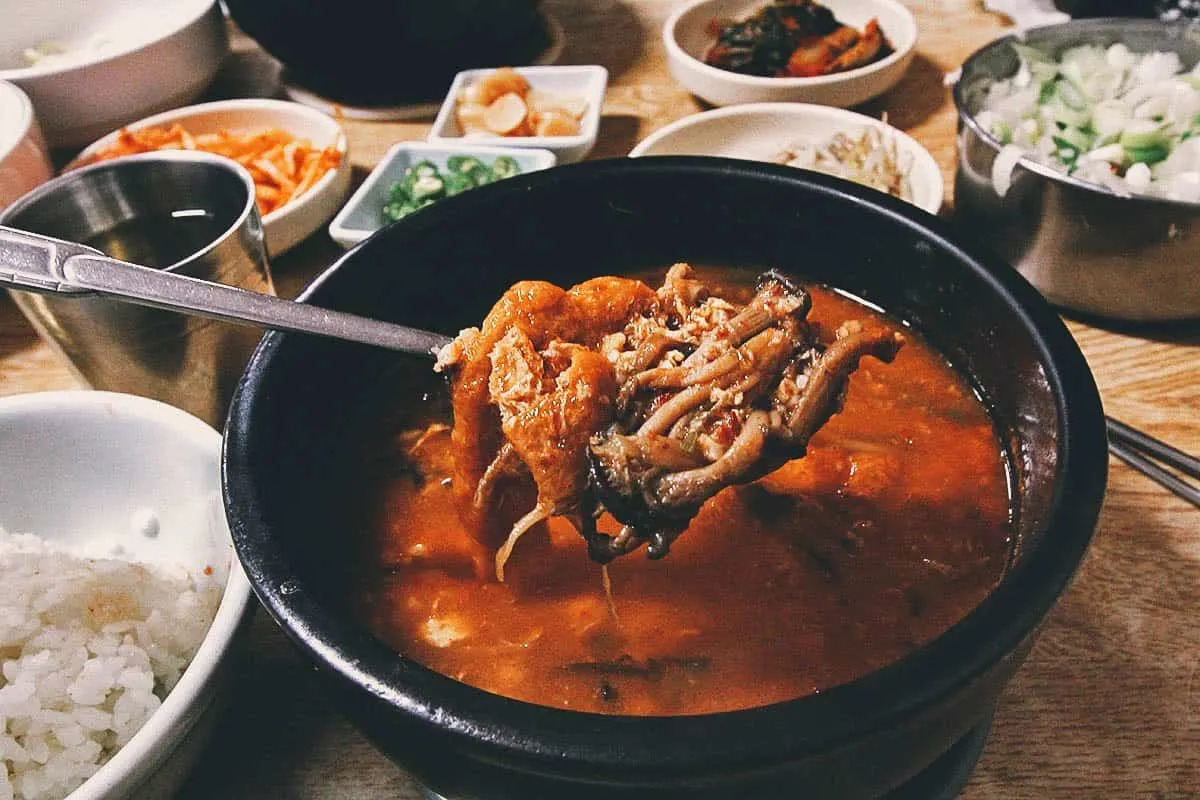
7. Ganjang Gejang
Many Koreans have described ganjang gejang as the ultimate South Korean food. I would agree.
Ganjang gejang refers to a traditional Korean dish of raw crab marinated in soy sauce. To make it, crabs are thoroughly cleaned then put in an earthenware crock where they’re salted for a period of about six hours.
A marinade of soy sauce, sugar, sesame oil, scallions, ginger, garlic, and red chili pepper paste is boiled briefly before being poured over the salted crabs.
An hour later, the marinade is removed, reboiled, and poured over the crabs again in a process that’s repeated several times before the dish is chilled and consumed.
Eaten cold, ganjang gejang is absolutely delicious, especially when paired with steamed white rice.
RECIPE: Ganjang gejang
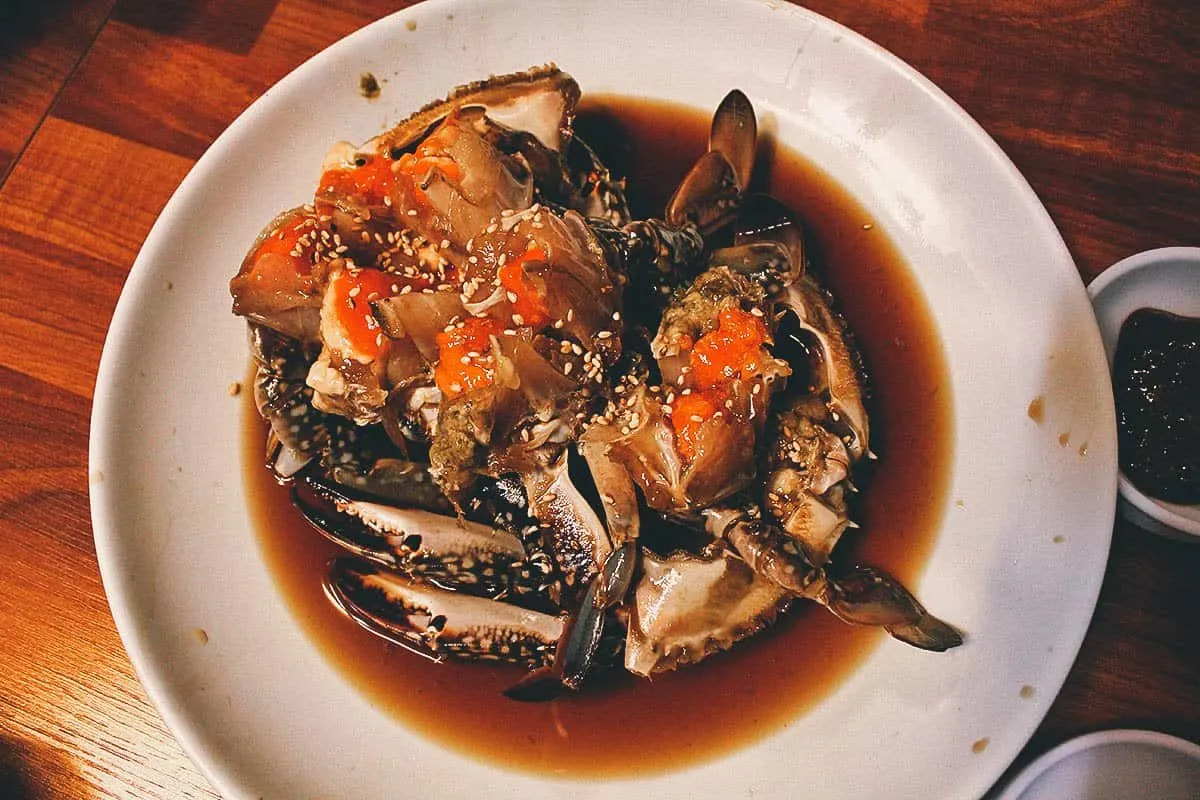
8. Gogigui (Korean BBQ)
When non-Koreans think of Korean food, kimchi and barbecued meat dishes are probably the first things that come to mind. They’re two of the most popular dishes in Korean cuisine.
Gogigui means “meat roast” and refers to the method of grilling meat like beef, pork, or chicken on gas or charcoal grills that are usually built into your dining table.
Different types of meat can be served marinated or unmarinated, some of the most popular being bulgogi (thin marinated slices of beef or pork) and galbi (marinated beef or pork ribs).
RECIPE: Soegogi-gui
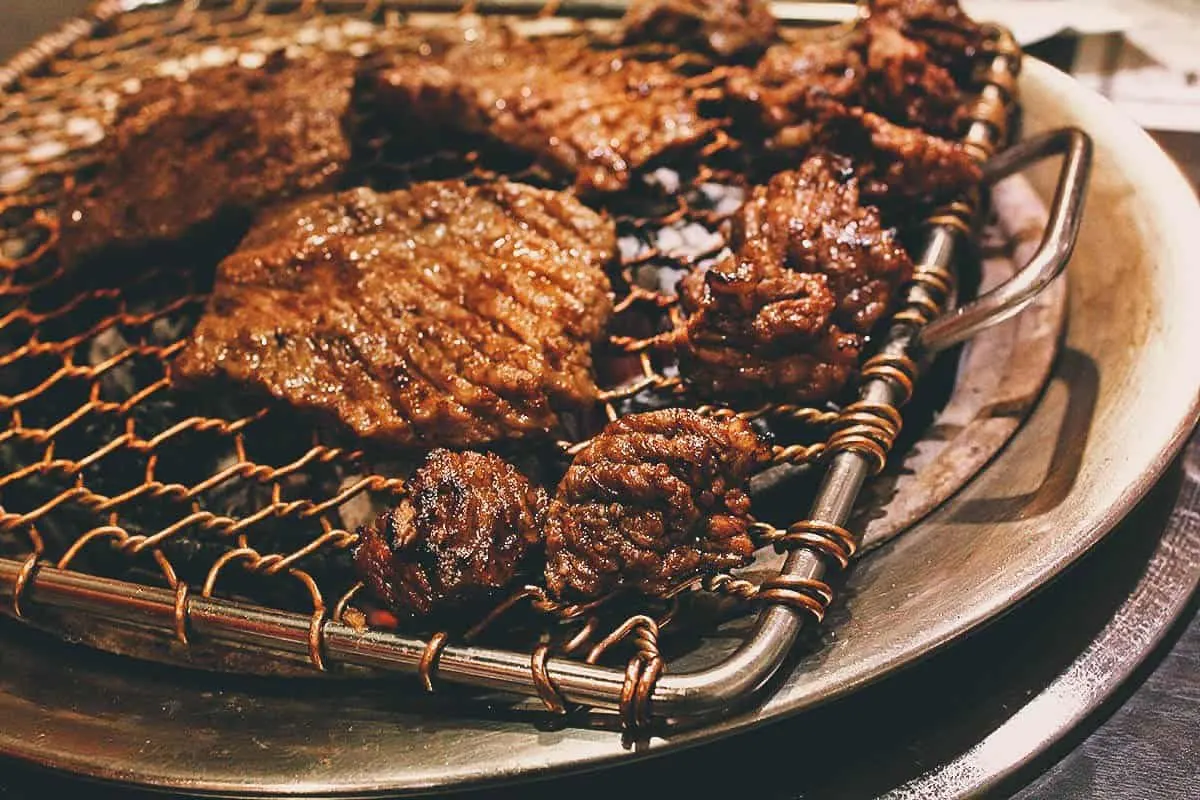
Meat dishes, especially when made with beef, is usually expensive in Korea. You usually need to get a minimum of two orders per cut of meat, but they do serve you a lot of banchan to go with your meal.
Pictured below is a Korean bbq meal consisting of pork rinds at a restaurant in Seoul.
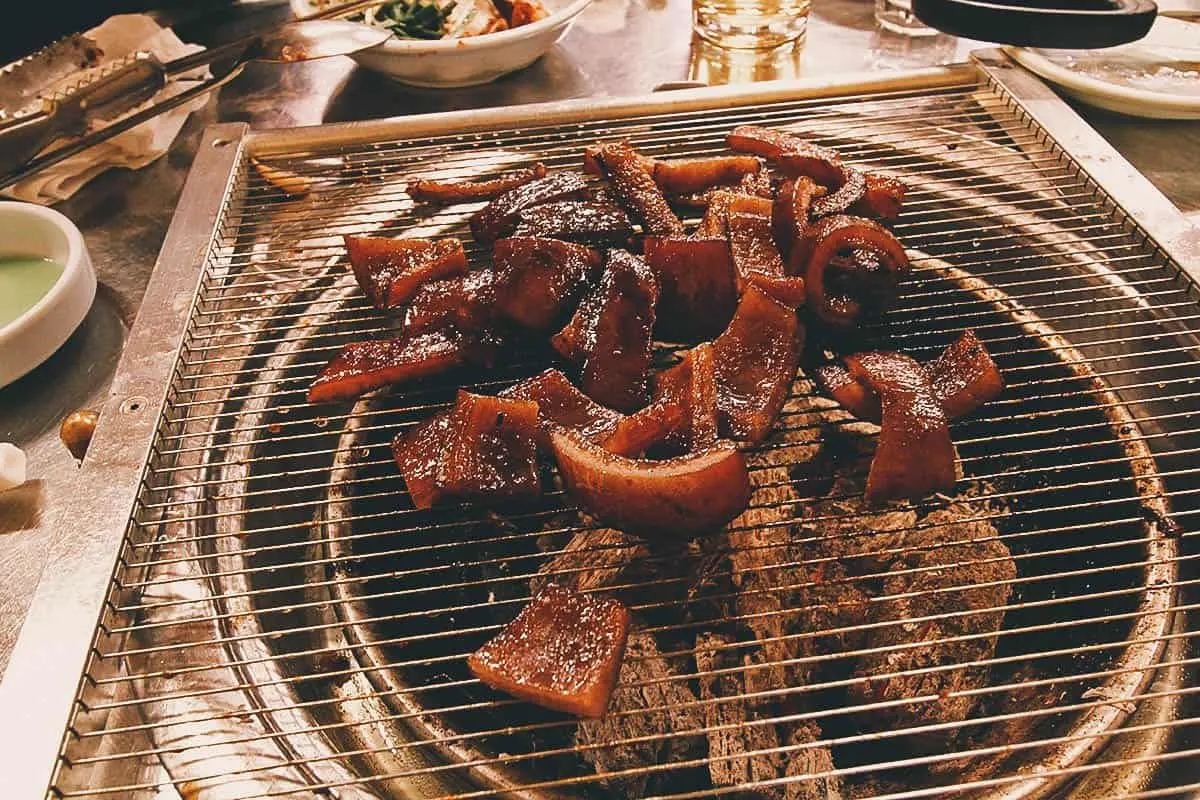
9. Gomtang
Gomtang or gomguk refers to a Korean beef bone soup. It’s made by simmering various beef parts like ribs, brisket, oxtail, and ox head or bones over a low flame.
The long simmering process creates a milky broth similar to seolnongtang. Rice is added to the soup and you can season the broth to taste with salt and minced green onion.
RECIPE: Gomtang
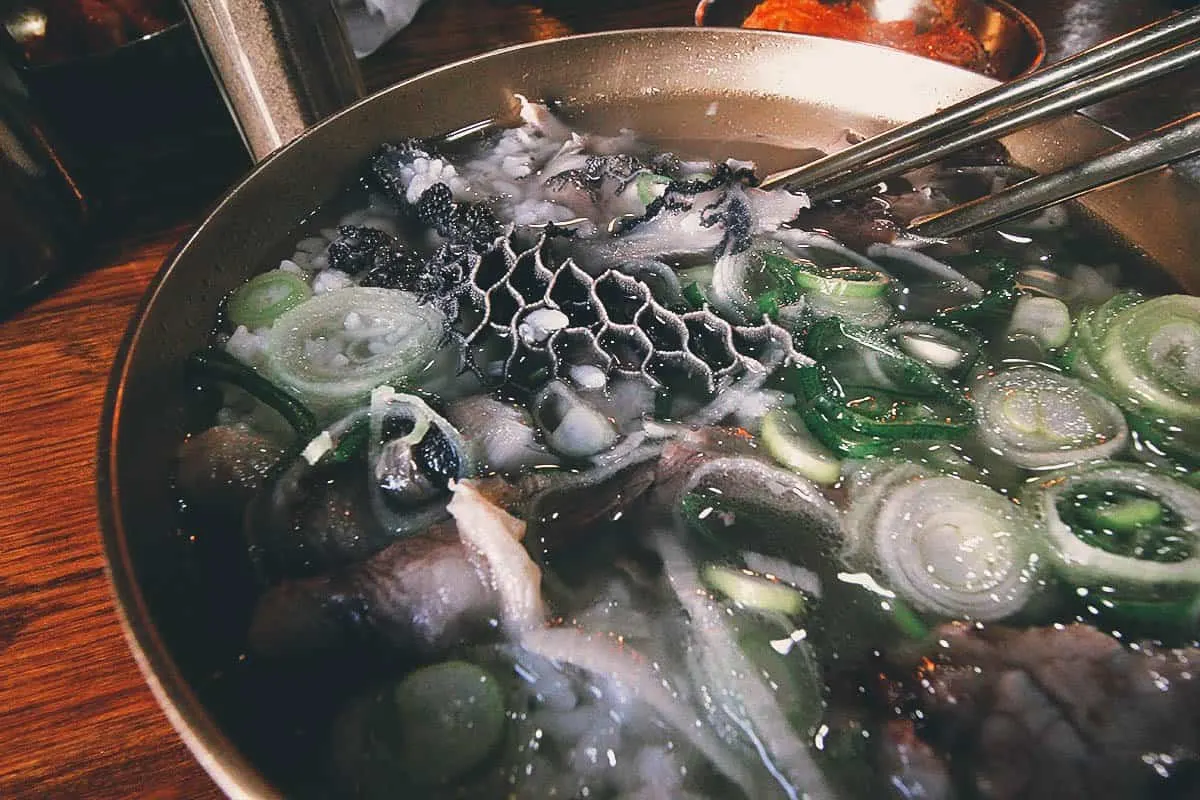
10. Jajangmyeon
Jajangmyeon is one of the most popular examples of Korean-Chinese food. It’s made with thick, handmade (or machine-pulled) wheat noodles topped with a heavy sauce made from fried chunjang (sweet bean sauce), soy sauce, diced pork, and vegetables.
It dates back to the early 20th century and was invented at a Chinese restaurant in Incheon’s Chinatown. Today, that restaurant has been converted into the Jajangmyeon Museum.
Interestingly, jajangmyeon has come to be associated with Black Day, an unofficial holiday celebrated on April 14 by unattached people in Korea. Korean men and women who don’t receive gifts on Valentine’s Day or White Day drown their sorrows in a black bowl of jajangmyeon.
RECIPE: Jajangmyeon
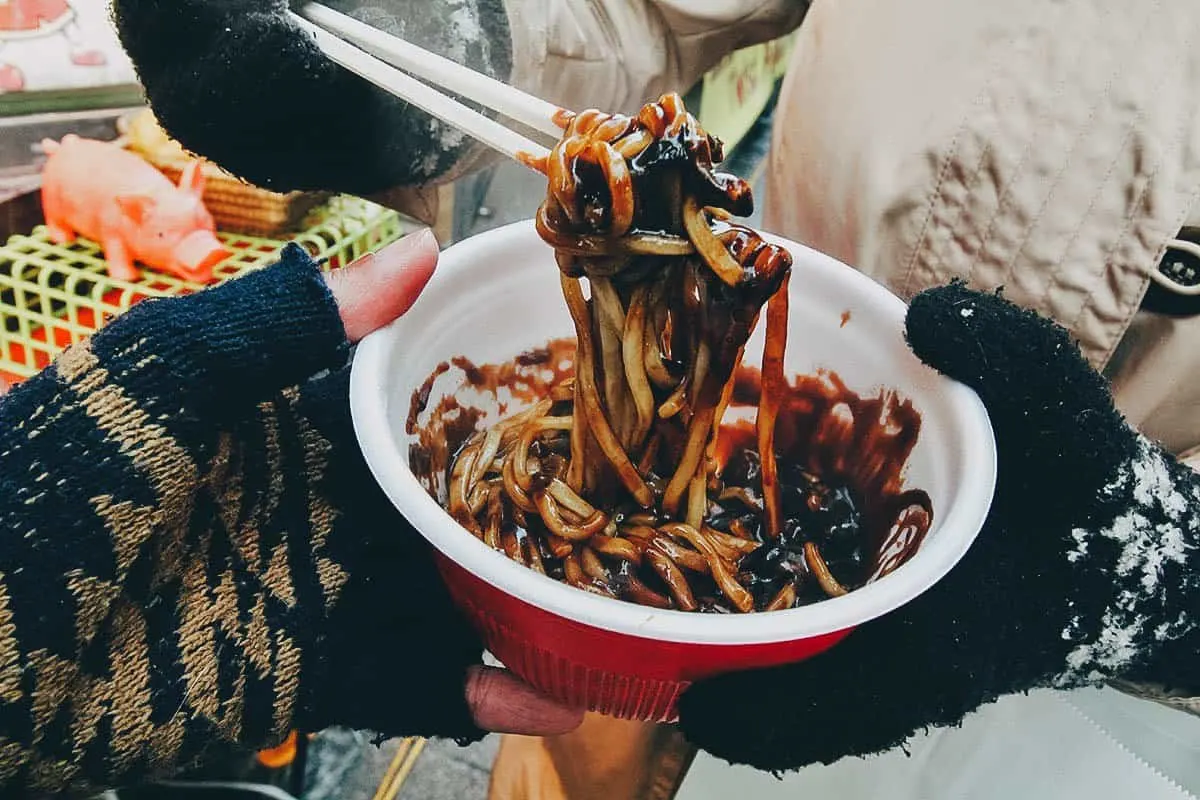
11. Japchae
Like kimchi and bulgogi, japchae is one of the most popular foods in Korea. Often served as a side dish, it refers to sweet and savory stir-fried glass noodles made with dangmyeon (sweet potato starch cellophane noodles) and topped with assorted vegetables, meat, and mushrooms.
It’s seasoned with soy sauce and sesame oil and commonly served as banchan. Japchae was once a royal dish that’s become one of the most popular Korean celebratory dishes, often served on special occasions like weddings, birthdays, and holidays.
RECIPE: Japchae
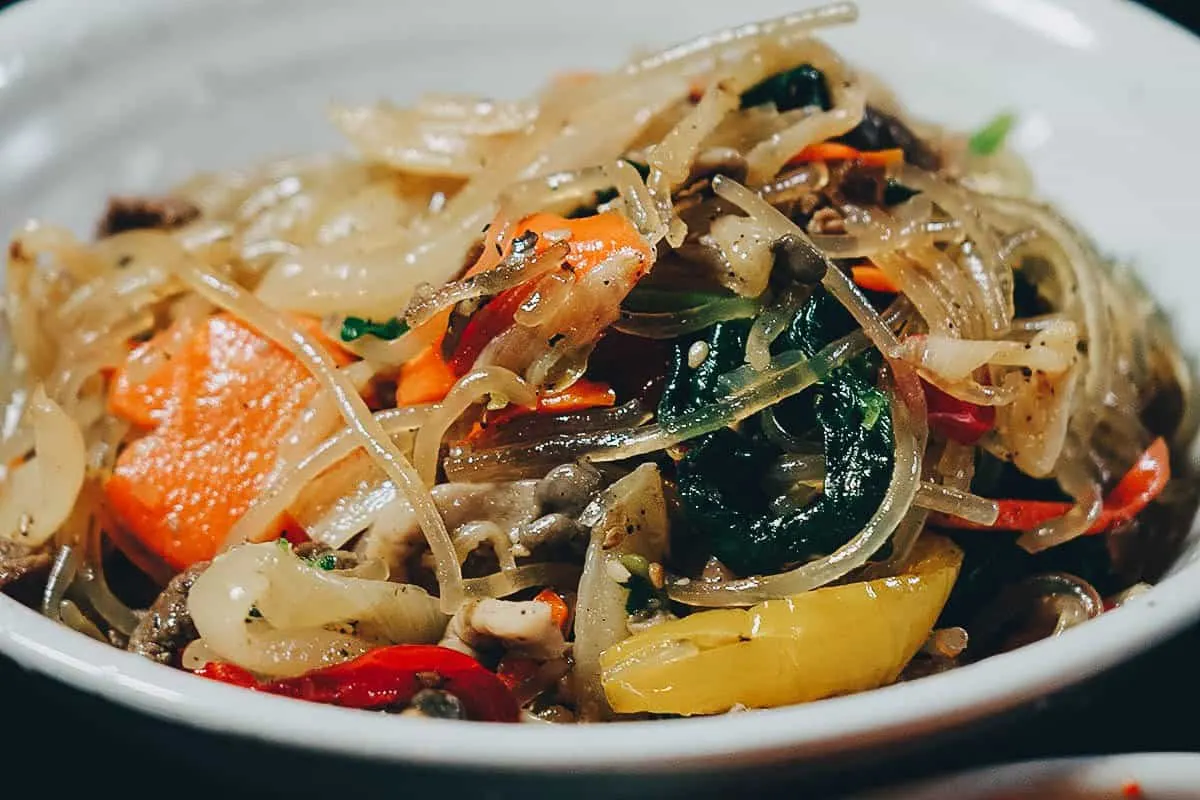
최광모, CC BY-SA 4.0, via Wikimedia Commons / Processed in Photoshop and Lightroom
12. Jjukumi
Jjukumi is a spicy Korean dish of stir-fried octopuses marinated in a red chili paste. It refers to both the dish and the species of octopus used in the dish, which is a smaller type of octopus commonly found along the coast of South Korea.
I have a high tolerance for spicy food and I found this dish to be almost too hot to eat. It’s considered spicy even by Korean standards so only try this dish if you have a fondness for spicy food.
RECIPE: Jjukumi gui
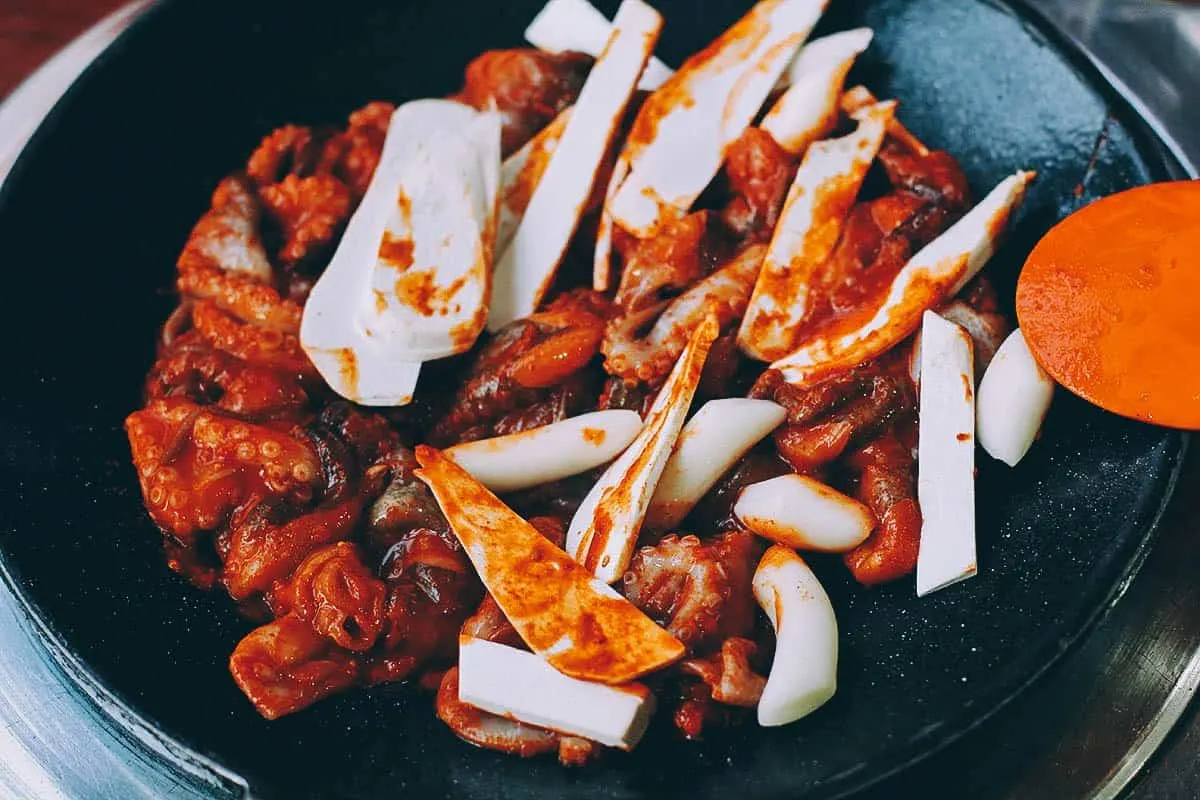
13. Jokbal
Jokbal refers to a Korean dish of pig’s trotters braised in soy sauce, ginger, garlic, and rice wine. Other ingredients like onions, leeks, garlic, cinnamon, and black pepper can also be used.
The trotters are simmered until fork tender before being deboned and cut into thick slices. They’re typically served with saeujeot, cloves of raw peeled garlic, and spicy peppers.
Like bossam, jokbal is a popular anju food often eaten with soju or beer. Pictured below is the same combination platter of jokbal and bossam from the Manjok Ohyang Jokbal restaurant in Seoul. The jokbal is on the left side of the plate.
RECIPE: Jokbal

14. Kalguksu
Kalguksu means “knife noodles” and refers to a Korean noodle dish consisting of handmade, knife-cut wheat flour noodles served in a large bowl with broth and other ingredients. Its name comes from the fact that the noodles aren’t extruded nor spun, but cut.
Kalguksu noodles are made with dough from wheat flour and eggs which is rolled out thinly and cut into long strips. Ingredients like dried anchovies, shellfish, and kelp are simmered for several hours to prepare the broth before the noodles and vegetables are added and boiled together.
RECIPE: Kalguksu
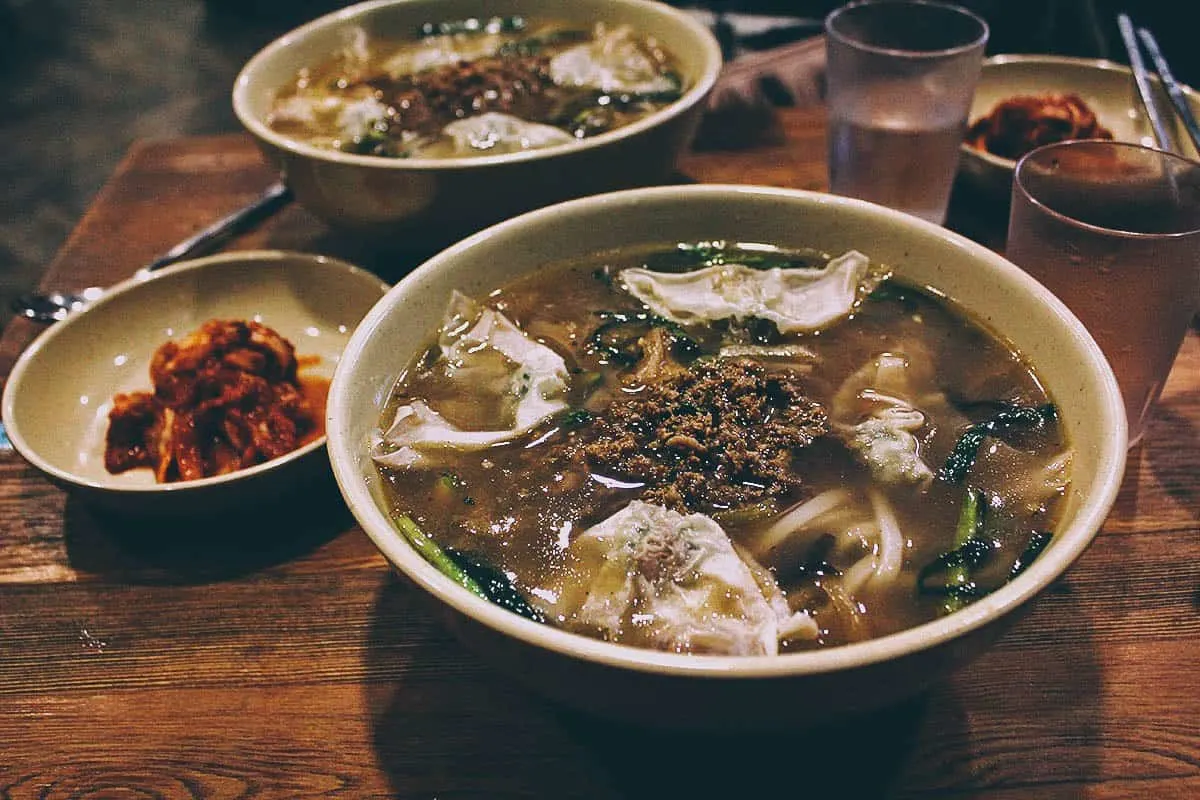
15. Kimchi
Without question, kimchi is the dish that’s most representative of Korean food and culture. It’s what most non-Koreans think of when they think of Korean food.
Kimchi is a traditional side dish made from salted and fermented vegetables – most commonly napa cabbage and Korean radishes – and a variety of seasonings like chili powder, scallions, garlic, ginger, and jeotgal (salted seafood).
There are hundreds of varieties of kimchi made using different vegetables as the main ingredient. It’s considered a national dish in both North and South Korea.
RECIPE: Tongbaechu kimchi
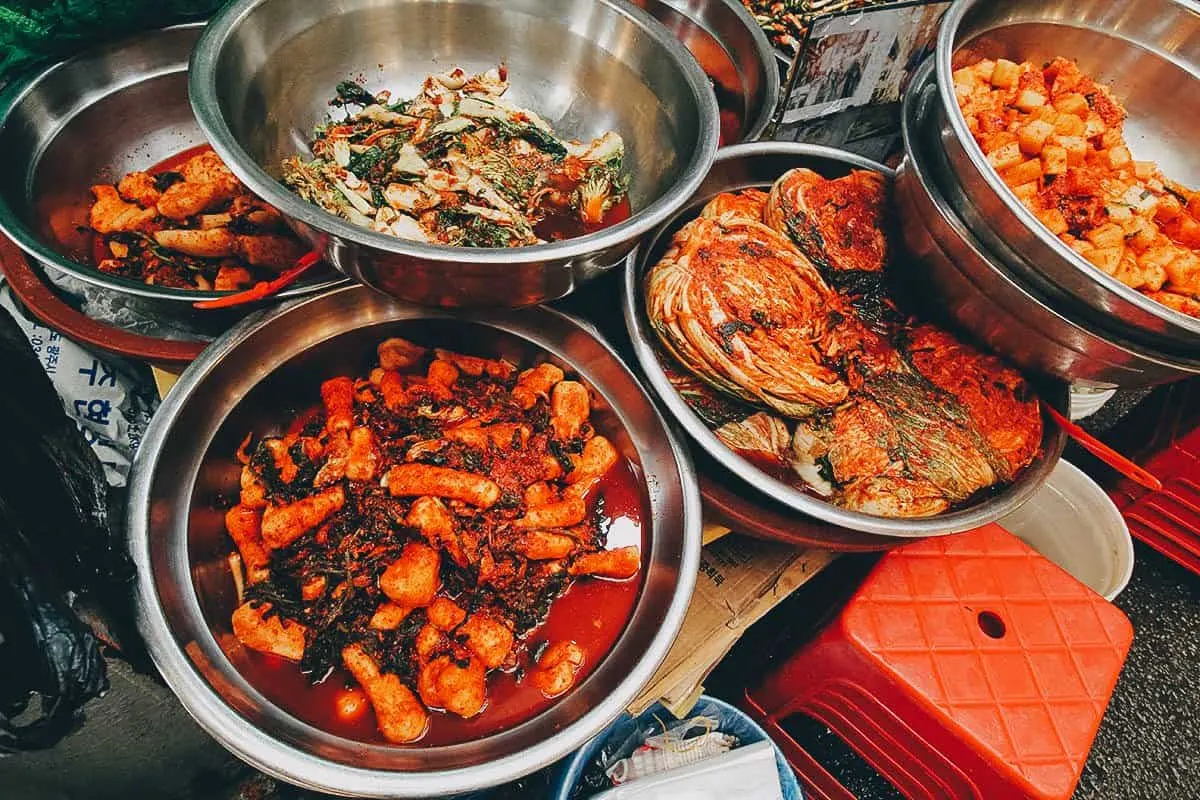
16. Makgeolli
Makgeolli refers to a Korean alcoholic beverage made from rice or wheat mixed with nuruk, a Korean fermentation starter. It has a milky off-white appearance thanks to a chalky sediment and tastes a little sweet and tangy.
Makgeolli is recognized as the oldest alcoholic beverage in Korea. It was brewed for centuries and was once considered a “farmer’s wine” or rural working-class beverage.
RECIPE: Makgeolli
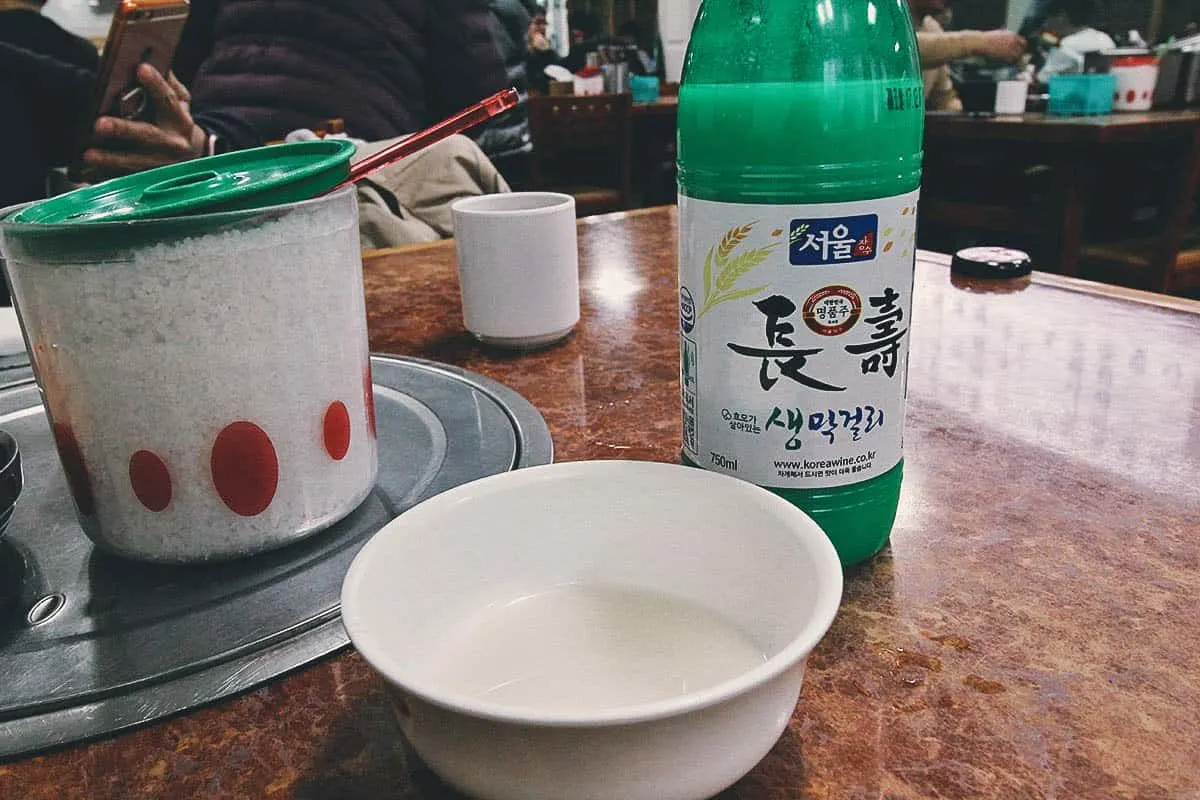
17. Mandu
Whether steamed, boiled, pan-fried, or deep-fried, mandu is the general term for Korean dumplings. They’re similar to Japanese gyoza or Chinese jiaozi and typically served with kimchi and a soy-vinegar-chili dipping sauce.
Mandu originated as a dish in Korean royal court cuisine but it’s now widely available throughout the country. You can enjoy different types of mandu at restaurants, outdoor food stalls, supermarkets, and pojangmacha (tented food stalls).
RECIPE: Mandu
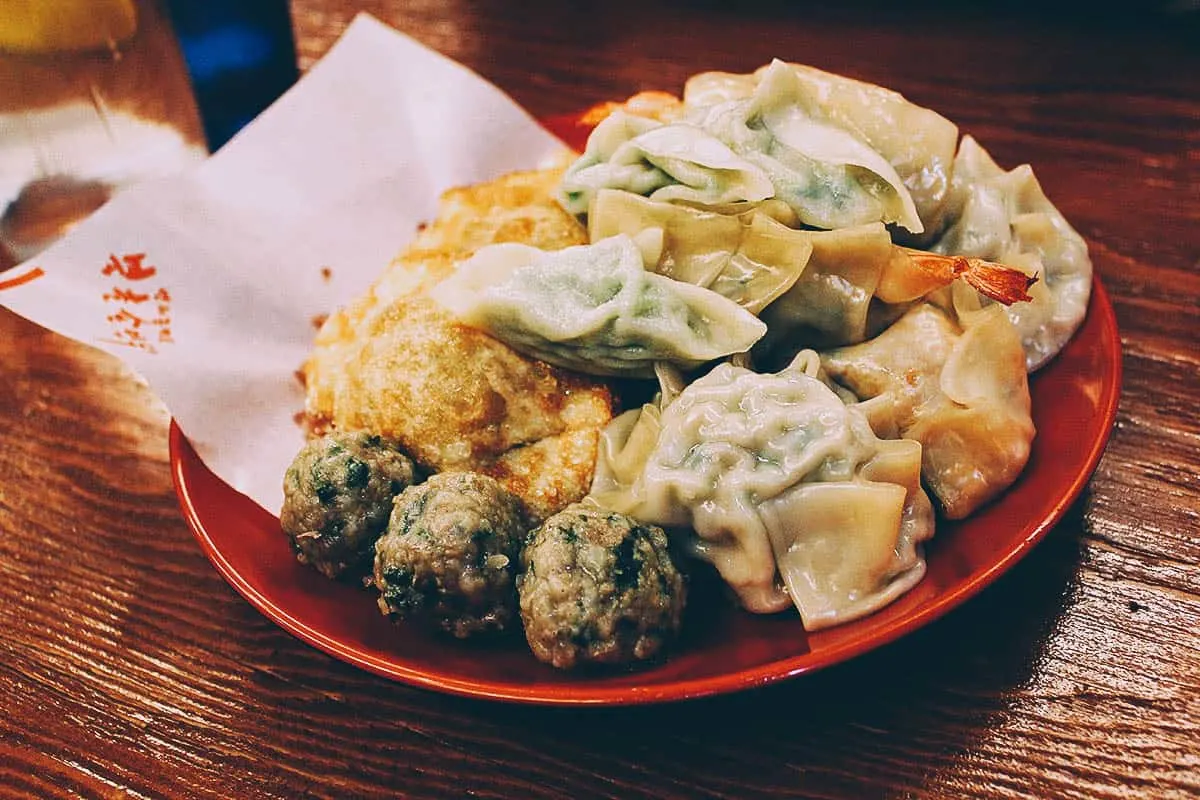
Pictured below is a bigger type of mandu called wang mandu. Filled with pork and vegetables, it reminded me of a cross between a siopao and a dumpling.
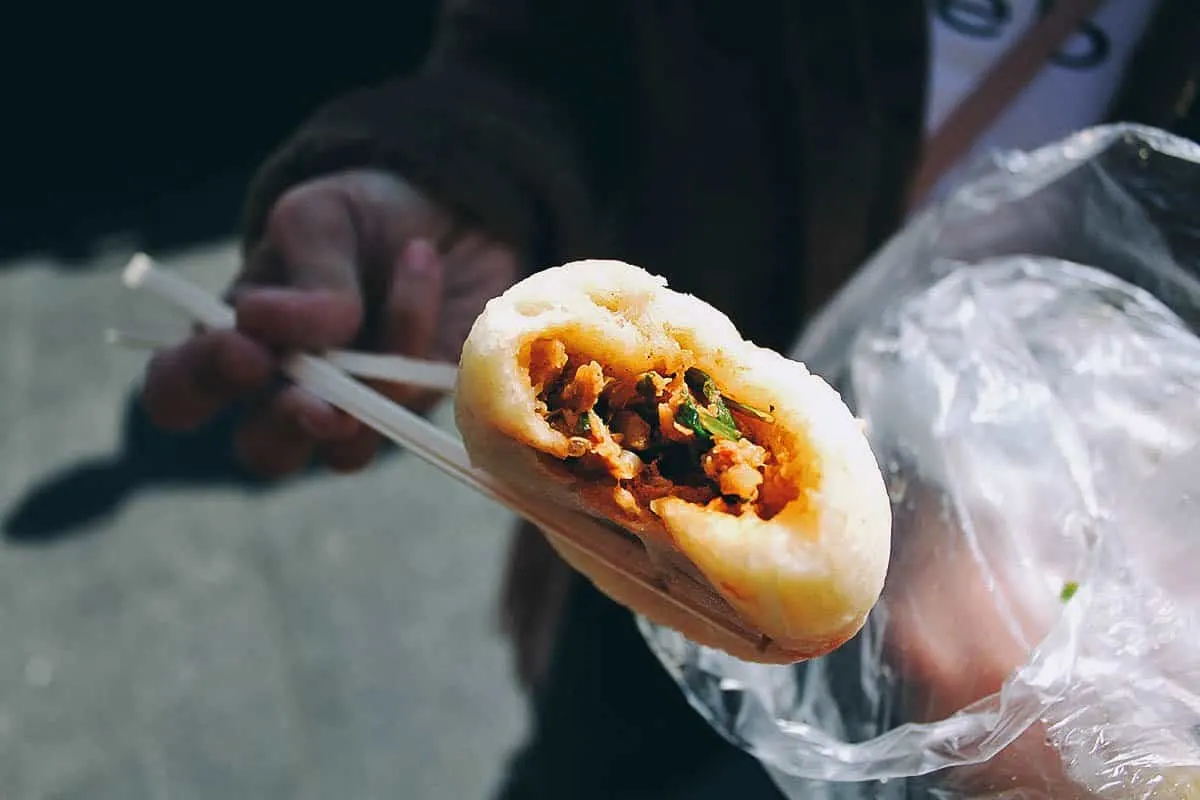
18. Naengmyeon
Naengmyeon is a Korean dish consisting of long and thin handmade noodles. It’s typically made with buckwheat noodles though it can be made from various other ingredients as well like potatoes, sweet potatoes, arrowroot starch, and kudzu.
Naengmyeon is originally a North Korean dish that became popular throughout Korea after the Korean War. It’s traditionally served in a large stainless-steel bowl with a tangy iced broth, julienned cucumbers, Korean pear, lightly pickled radish, and either a boiled egg or slices of cold boiled beef (or both).
Traditionally, naengmyeon is eaten without cutting the buckwheat noodles to symblize long life and good health.
RECIPE: Mul-naengmyeon
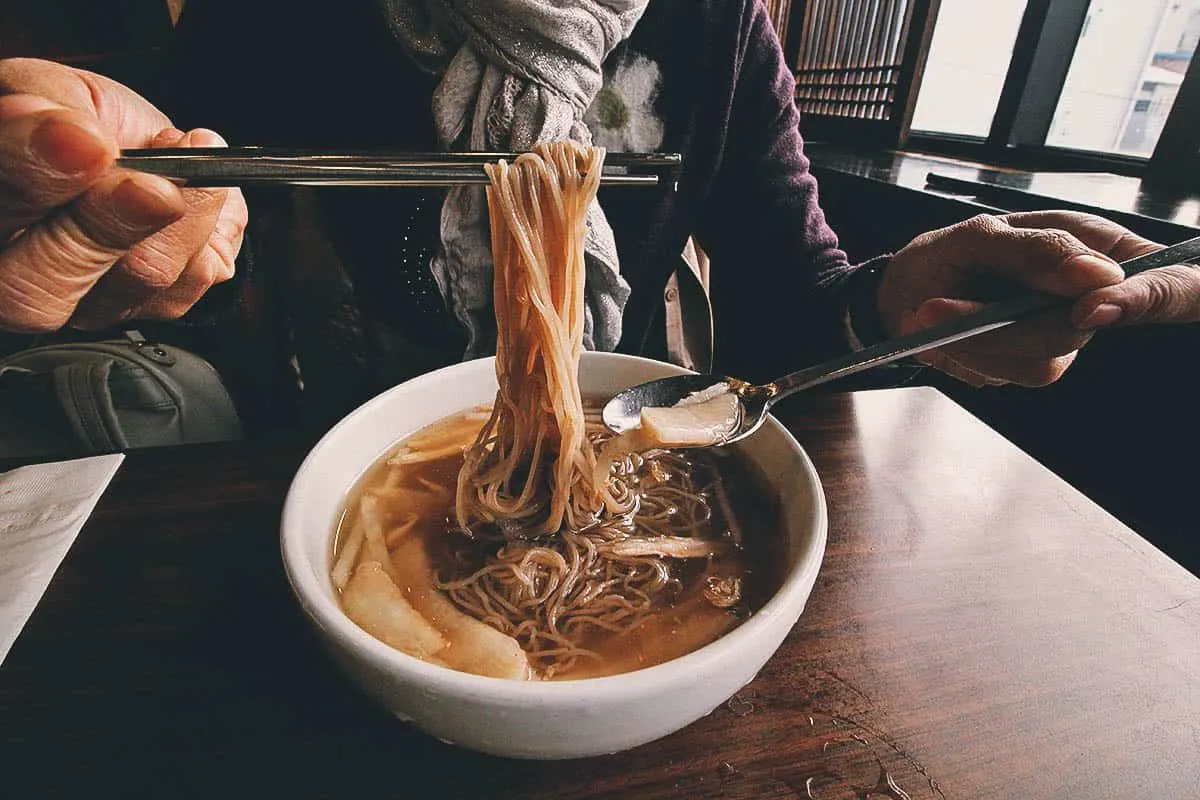
19. Nakji Bokkeum
Nakji bokkeum refers to a stir-fried dish made with chopped octopus and vegetables marinated in gochujang, soy sauce, garlic, salt, and sugar. It’s a mildly spicy dish and one of my favorite things to eat in Korean cuisine.
A version of this dish can be made with squid instead of octopus. It’s called ojingeo bokkeum and tastes pretty much the same as nakji bokkeum.
RECIPE: Nakji bokkeum
20. Haemul Pajeon
The word Jeon refers to a family of fried Korean dishes coated with wheat flour and egg wash. It can be made with a variety of ingredients like fish, meat, poultry, seafood, and vegetables. In the case of pajeon, the main ingredient is pa or scallions.
Pajeon can be made with a batter of just eggs, wheat flour, rice flour, and scallions, though other ingredients like beef, pork, kimchi, squid, shrimp, and seafood can also be used. When it’s made with scallions and seafood, it’s known as haemul pajeon. Haemul means “seafood”.
When cooked, haemul pajeon resembles a fried Korean pancake with scallions and seafood running through it. Often enjoyed as a side dish, it’s usually served with a dipping sauce made with soy sauce.
RECIPE: Haemul pajeon
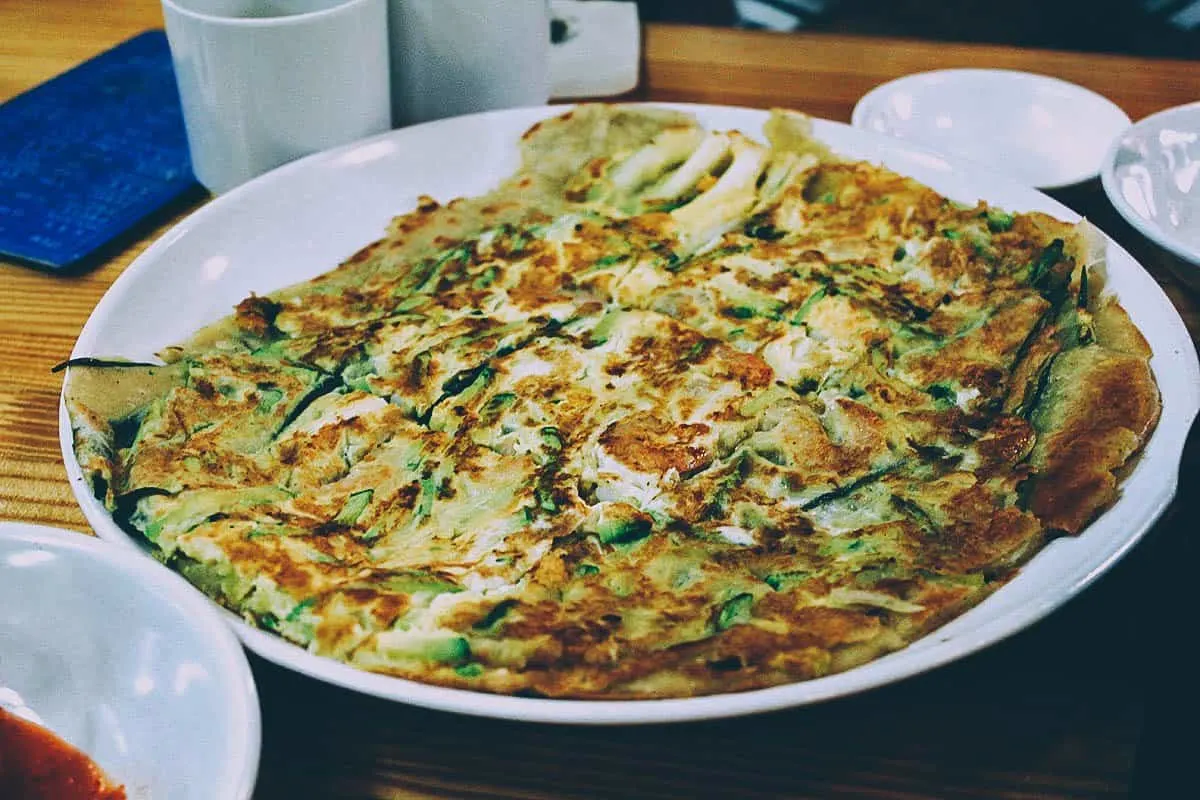
21. Samgyetang
Samgyetang is one of the more interesting dishes in Korean cuisine. It literally means “ginseng chicken soup” and refers to a hot soup made from a whole young chicken stuffed with glutinous rice and boiled in a broth of Korean ginseng, jujube fruits, garlic, ginger, and various herbs and condiments.
In spite of being a hot soup-like dish, samgyetang is considered a summer food. It’s a medicinal dish that’s believed to cool your body by emitting sweat, and boost your energy by facilitating blood flow in the internal organs. This is founded on the traditional Korean principle of Yi Yeol Chi Yeol, meaning “fighting heat with heat”.
RECIPE: Samgyetang
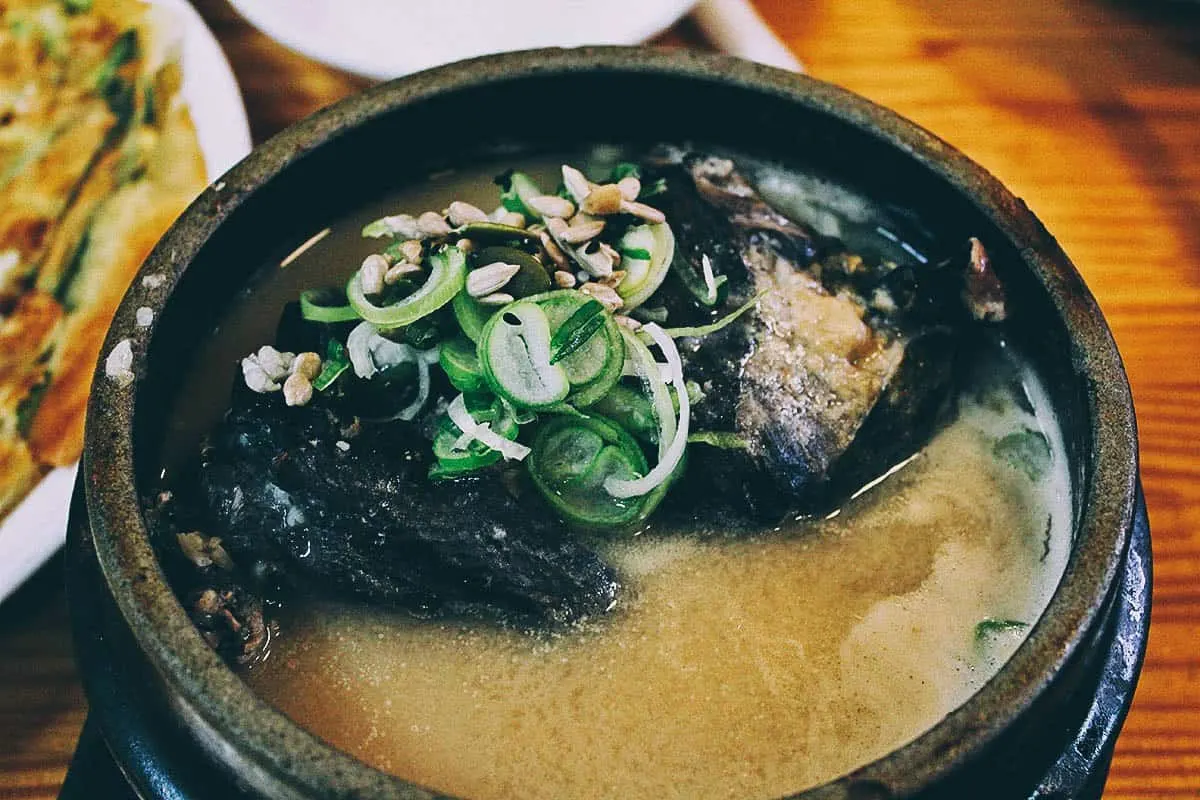
22. Sannakji
Sannakji refers to the infamous Korean dish of octopus sashimi, perhaps one of the strangest and most controversial dishes in Korean cuisine.
What makes it controversial is the fact that the tentacles are still wriggling, even after it’s been chopped up and served to you. The octopus is already dead but the tentacles continue to move because the ganglia are still intact.
The ganglia enable the arms to operate independently of the octopus and react to stimuli, hence the continued movement. This means that the suction cups still work so you’re advised to chew it well before swallowing.
Like any type of sashimi, sannakji is usually eaten with soy sauce and wasabi. We don’t intend to try it but sannakji can also be served with live whole octopus.
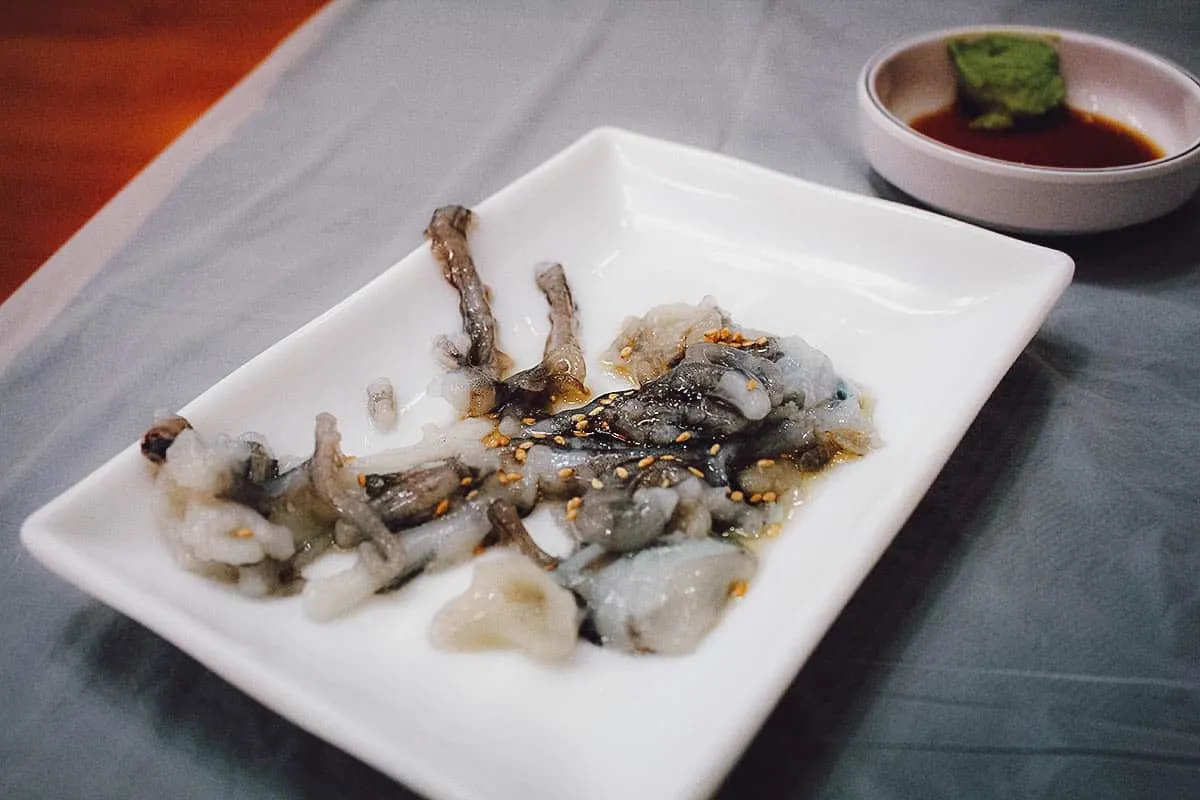
23. Seolleongtang
Seolleongtang refers to a traditional Korean ox bone soup made with brisket and other cuts of meat. A popular comfort food in Korea, it’s made by boiling beef shank bones for several hours, even up to an entire day, to gradually extract the flavor from the bones.
This slow simmering process turns the broth cloudy and milky white. Brisket and other cuts of beef are then added to the broth along with rice and soft wheat noodles.
Salt, ground black pepper, red pepper, minced garlic, and chopped spring onions are made available on your table so you can season your ox bone soup to taste.
RECIPE: Seolleongtang
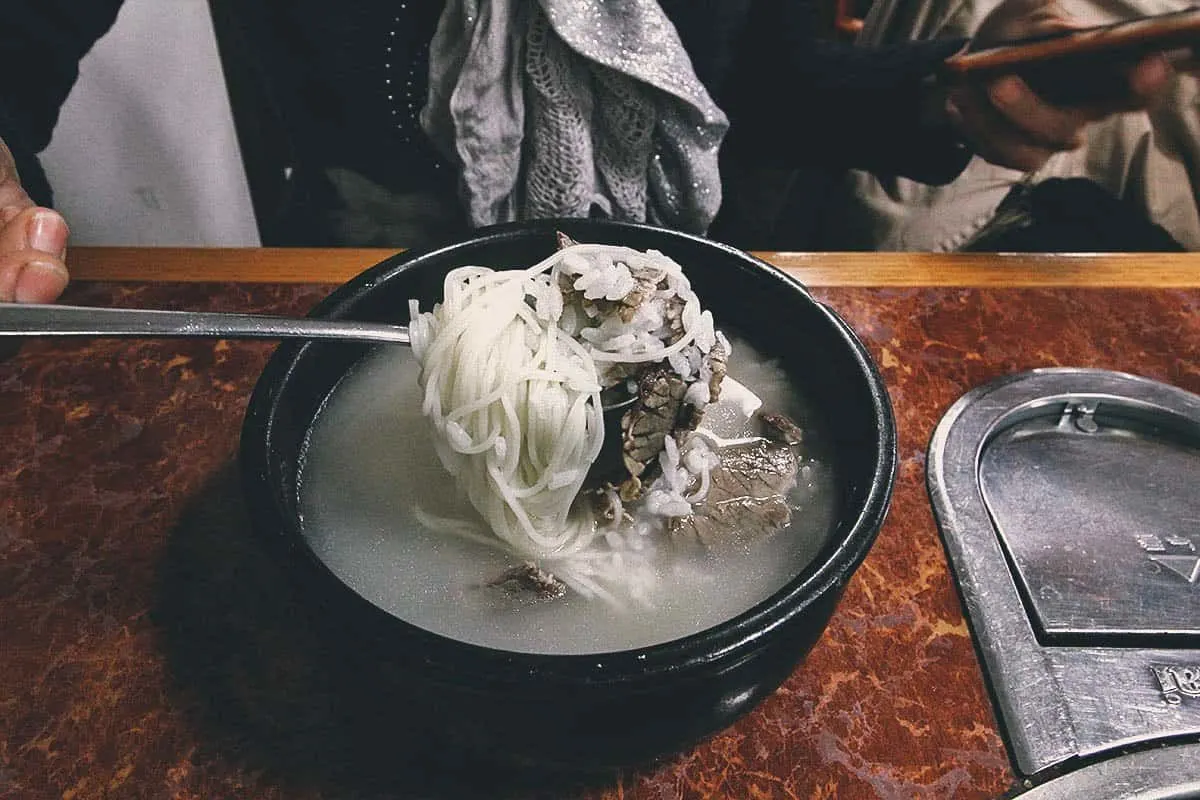
24. Sundubu Jjigae
Sundubu jjigae is a type of jjigae or Korean stew made with freshly curdled soft tofu, kimchi, vegetables, onions, and gochujang or gochugaru. Seafood, meat, and a raw egg can also be added as optional ingredients.
This Korean soft tofu stew is assembled and cooked directly in a serving earthenware vessel known as a ttukbaegi. It’s typically served at the start of your meal along with a few plates of banchan and steamed white rice.
RECIPE: Sundubu jjigae
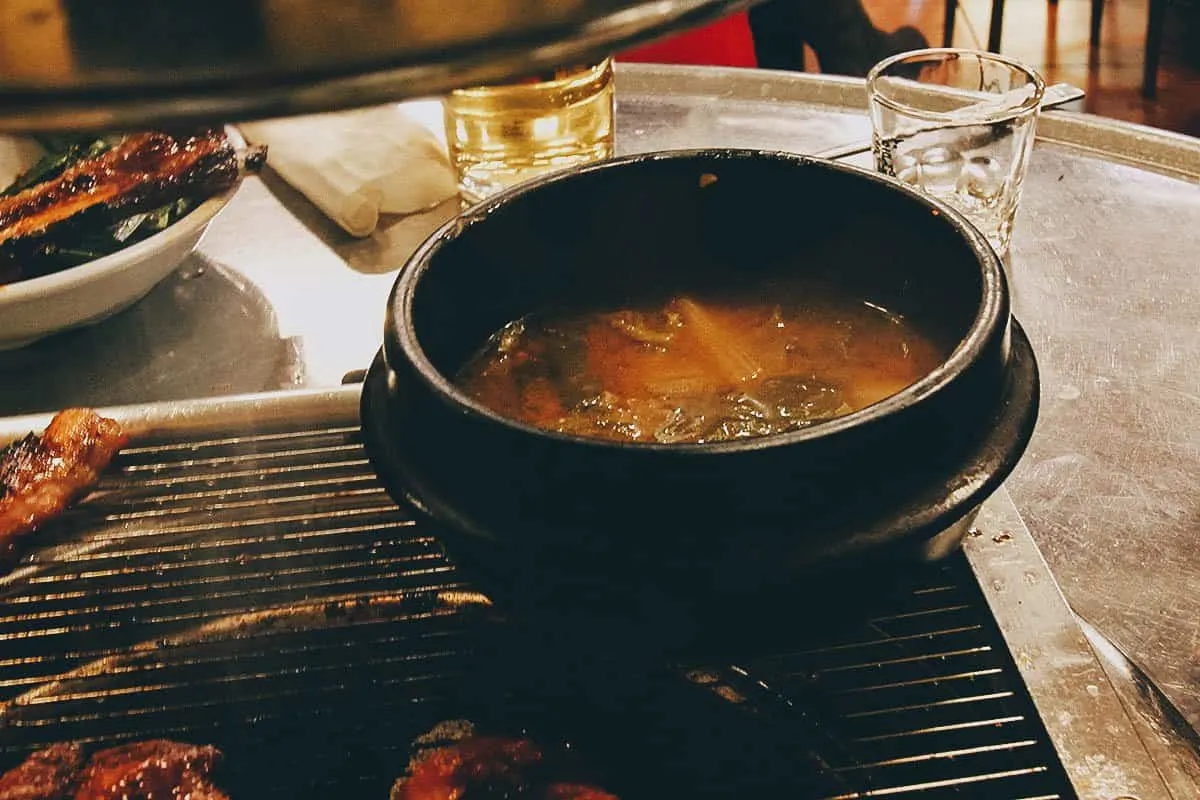
KOREAN STREET FOOD
This section lists some of the most popular and interesting street food dishes you can find in South Korea. For more recommendations, be sure to check out our guide on Korean street food.
25. Beongdegi
I didn’t want to start the street food section of this Korean food guide with something as exotic as beongdegi, but the dishes are listed in alphabetical order so I had no choice!
Beongdegi is stewed silkworm larvae. It isn’t the prettiest Korean food but it actually tastes better than it looks. it’s served boiled or steamed in paper cups and tastes soft, nutty, and very juicy.
I read that beongdegi is a dying snack but you may chance upon them at Korean food markets like Nandaemun or Gwangjang Market. We tried it in Jinhae during the Jinhae Cherry Blossom Festival.
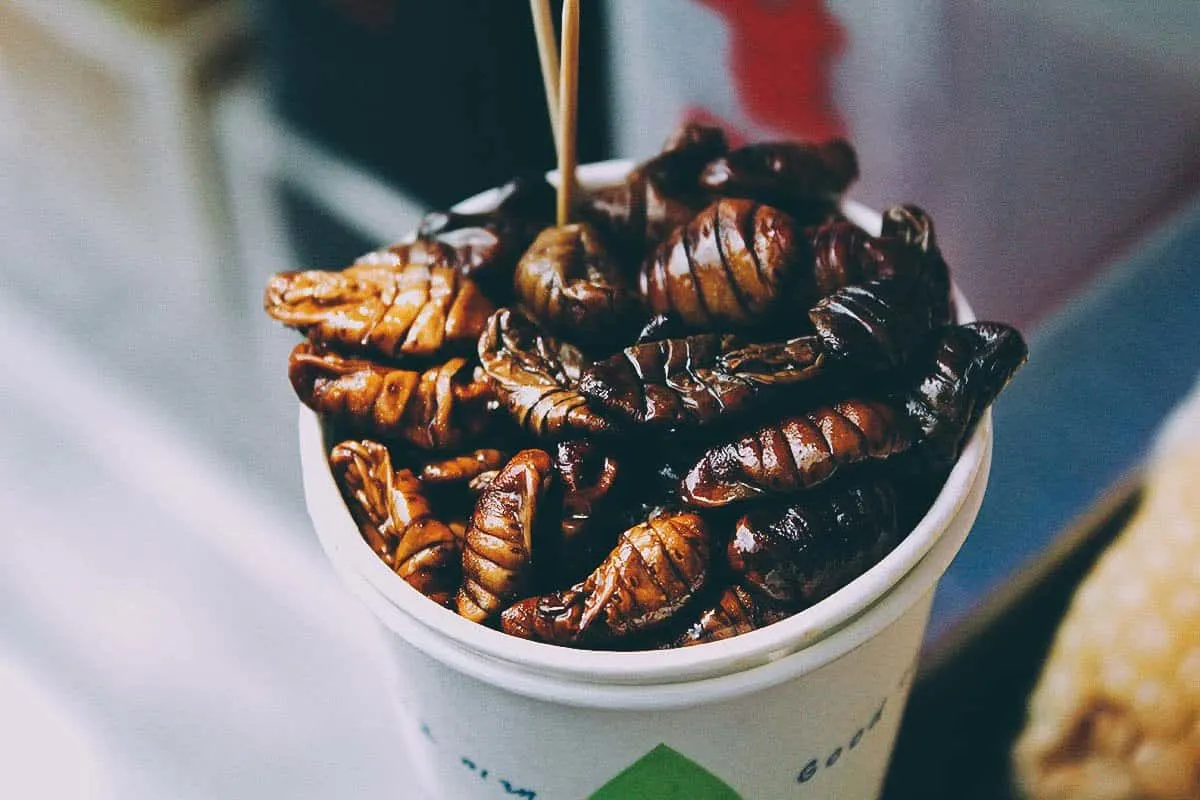
26. Bindaetteok
Bindaetteok refers to a mung bean pancake originally from Pyongan Province. It’s made by grinding soaked mung beans into a batter and adding a filling made with kimchi, fiddlehead fern, mung bean sprouts, scallions, and pork.
The bindaetteok is pan-fried into a round flat shape and served with a dipping sauce made with soy sauce, vinegar, water, and ground pine nuts. In Seoul, you’ll find many vendors selling bindaetteok at Gwangjang Market.
RECIPE: Bindaetteok
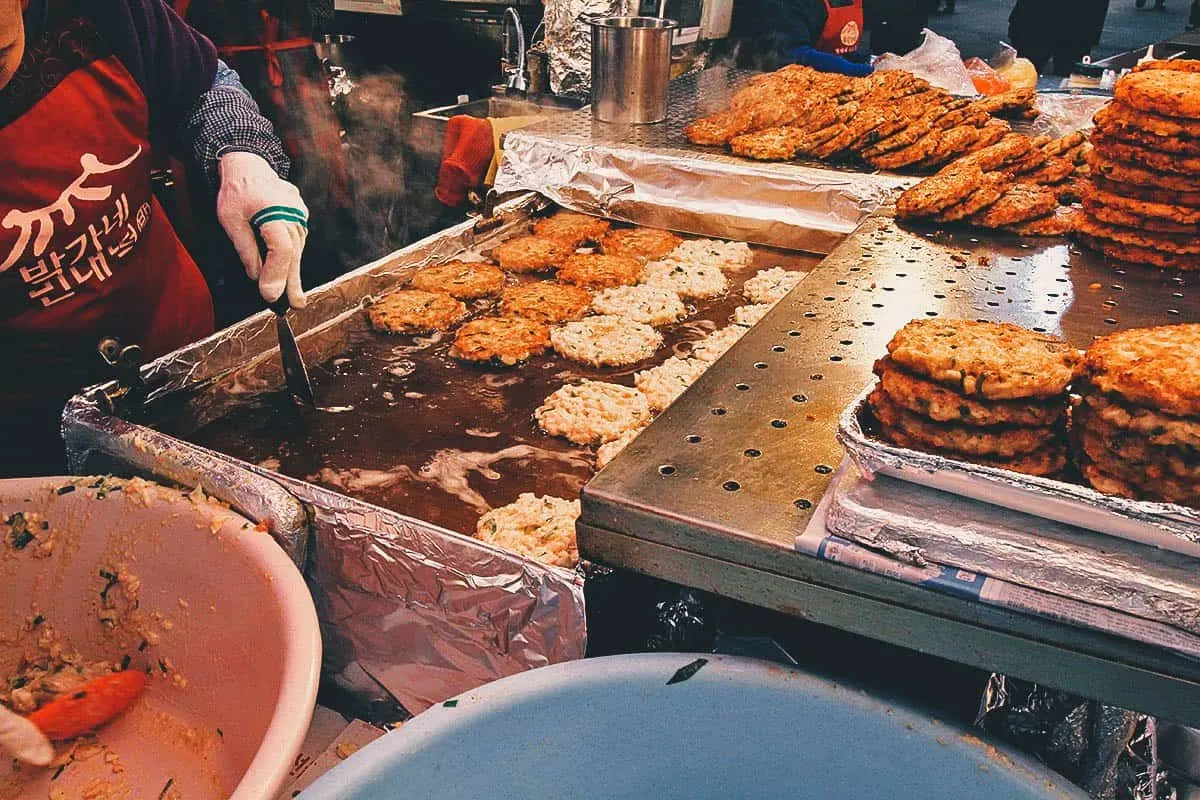
27. Crispy Crablets
Crispy crablets are small deep-fried crabs. They’re lightly seasoned and have a texture similar to soft shell crabs.
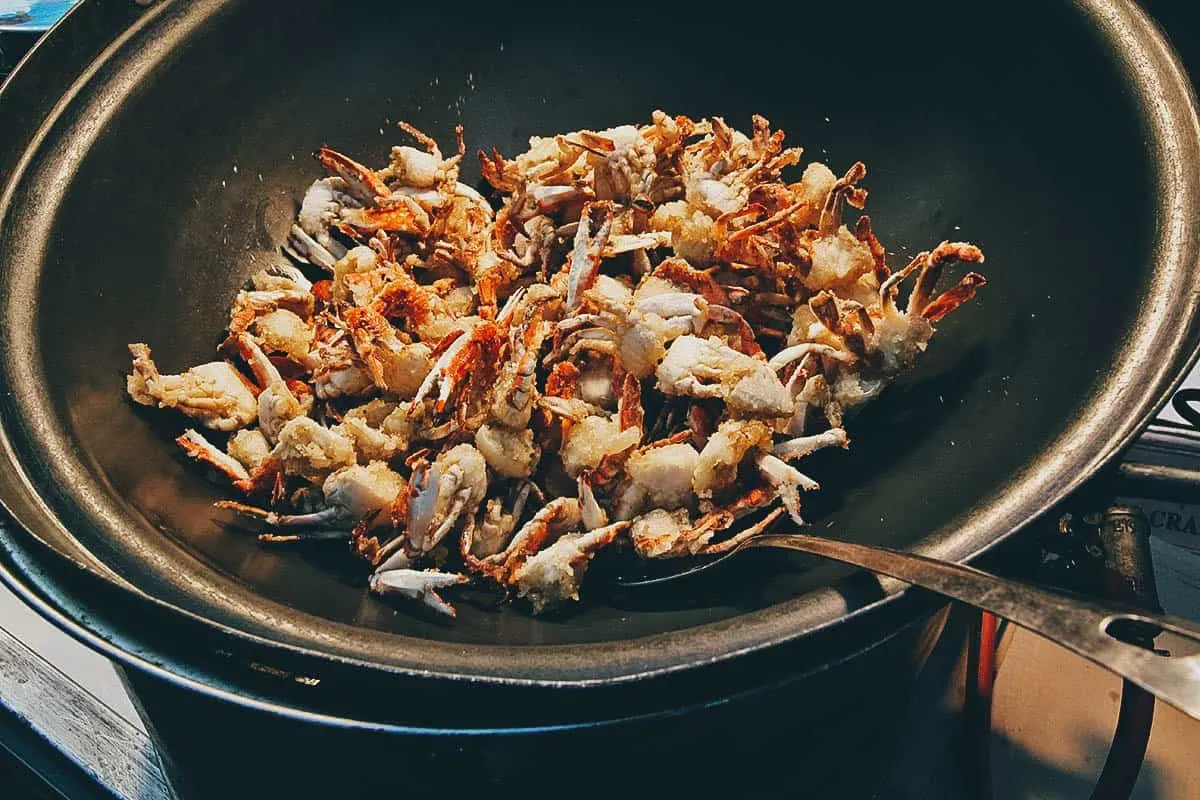
28. Dakkochi
Dakkochi refers to a delicious Korean dish of grilled chicken and scallion skewers. It’s the most popular type of kkochi or skewered Korean food.
The chicken is cut into thin slices and skewered with scallions before being grilled and brushed with a spicy-sweet red chili sauce.
RECIPE: Dakkochi
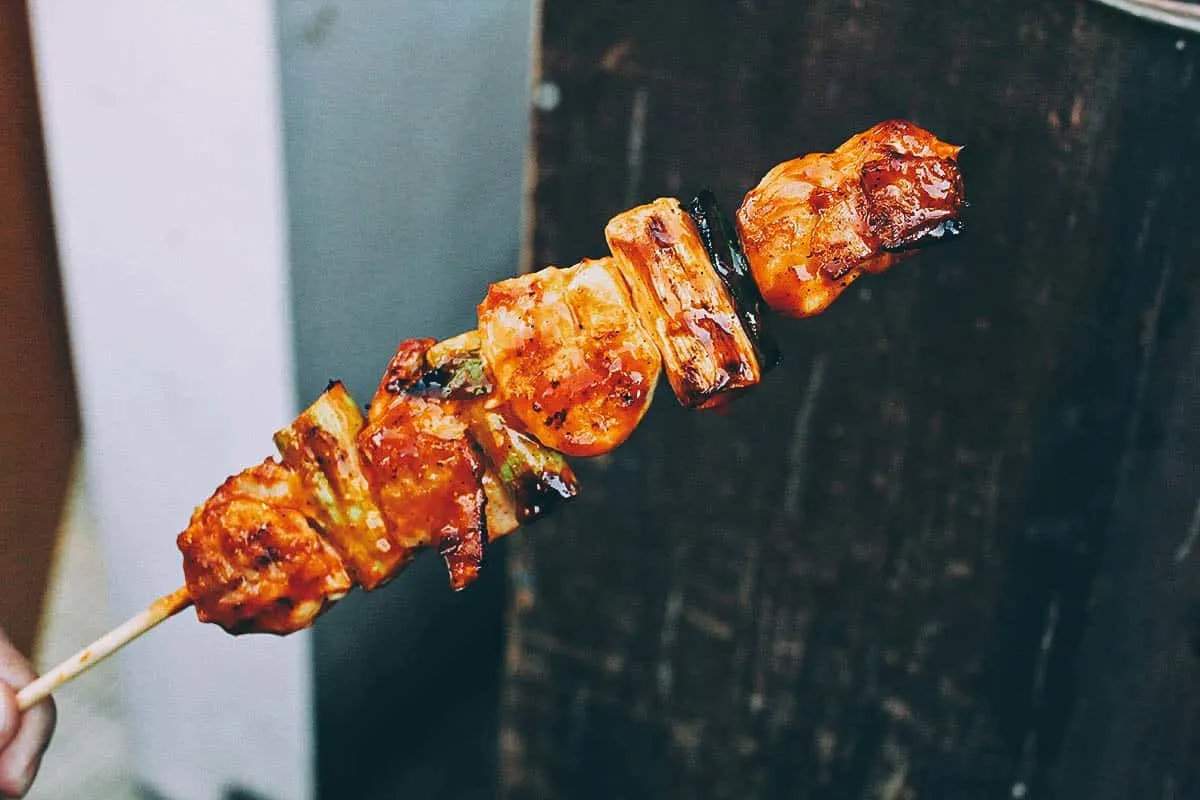
29. Eomuk / Odeng
Eomuk (or odeng) refers to fishcake. It was introduced to Korea during the Japanese occupation and has since become one of the most popular Korean foods.
Eomuk is made with ground white fish and other ingredients like potato starch, sugar, and vegetables. You can enjoy it at restaurants or food stalls pretty much anywhere in Korea.
Pictured below is a dish called eumok tang, or skewered fishcakes served in broth.
RECIPE: Eumok
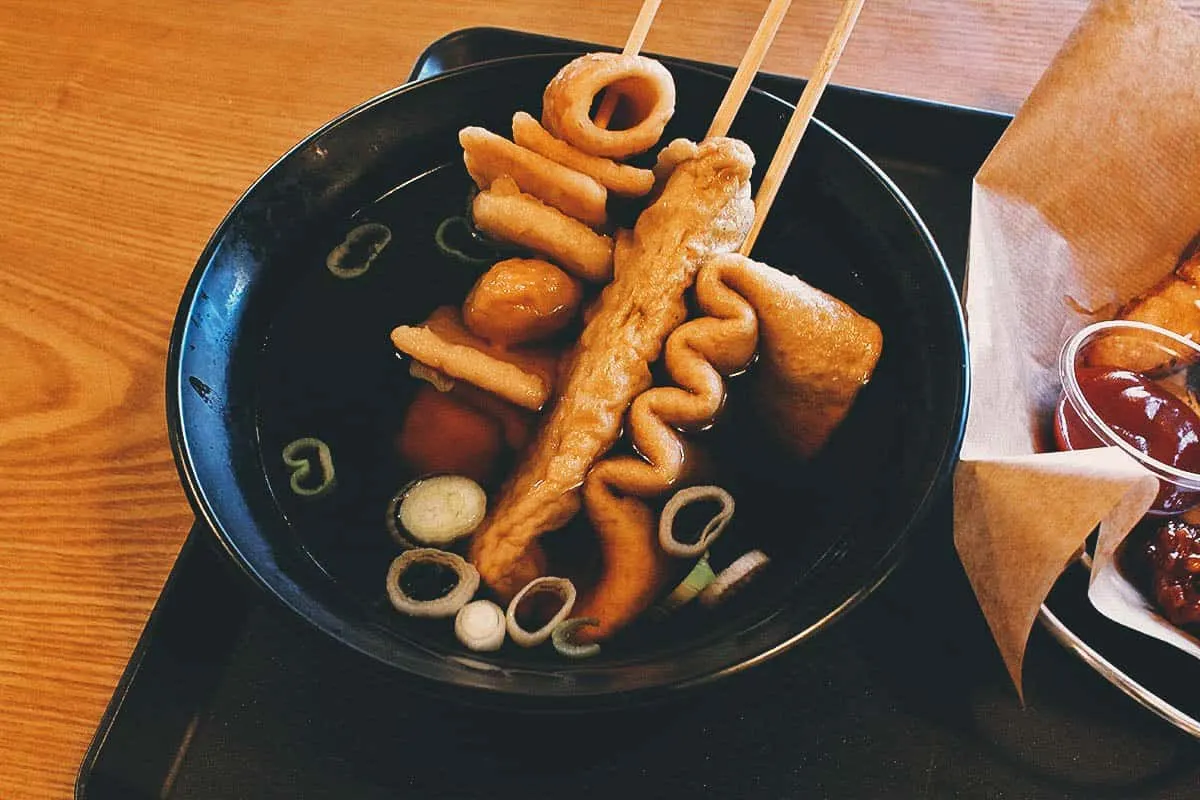
Aside from the skewered version, eomuk is also commonly available in cylindrical form. It’s often filled or mixed with other ingredients like cheese, vegetables, sausage, and tteokbokki (rice cakes).
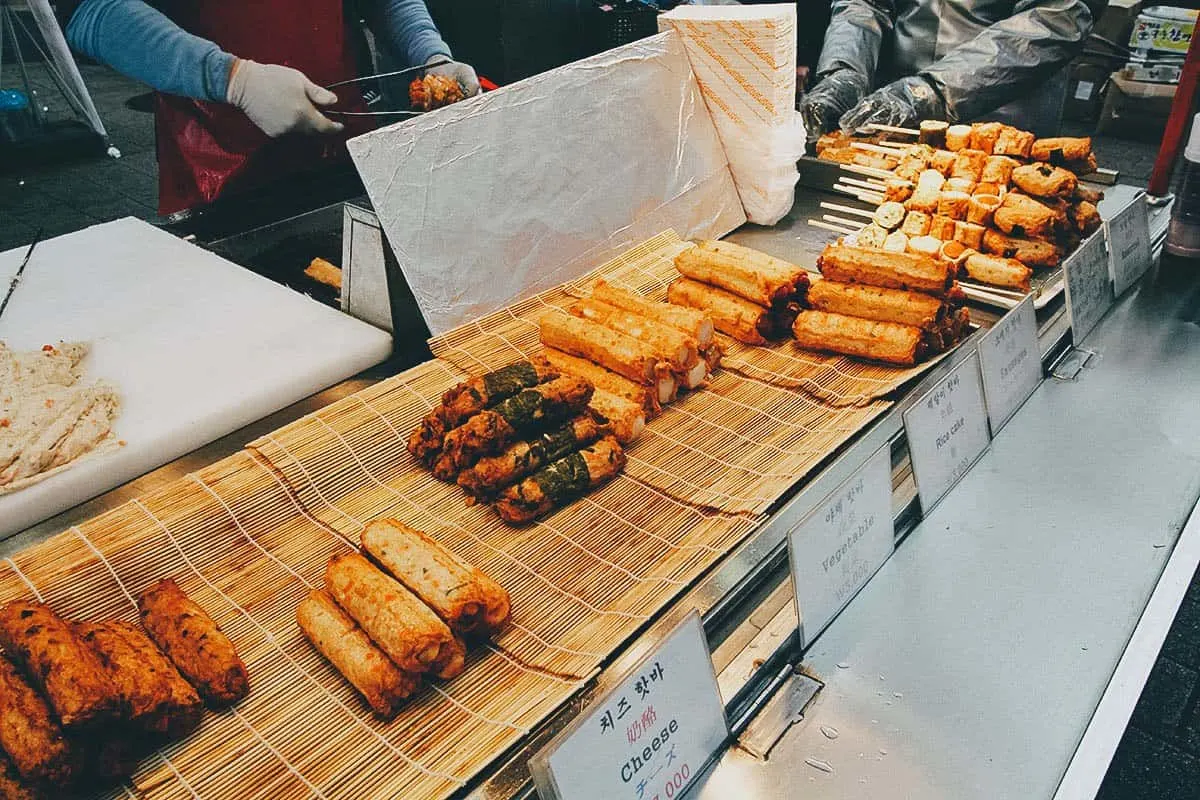
30. Gyeranppang
This was one of my favorite Korean dishes. Gyeranppang means “egg bread” and refers to these fluffy, oblong-shaped loaves of bread made with whole eggs.
An entire egg is cracked into oblong-shaped slots filled with cake batter which is cooked until golden brown. They’re rich and eggy with a slightly crisp, chewy crust.
Common gyeranppang toppings include chopped parsley, cheese, and diced ham, but I prefer them as is. They’re so good.
RECIPE: Gyeranppang
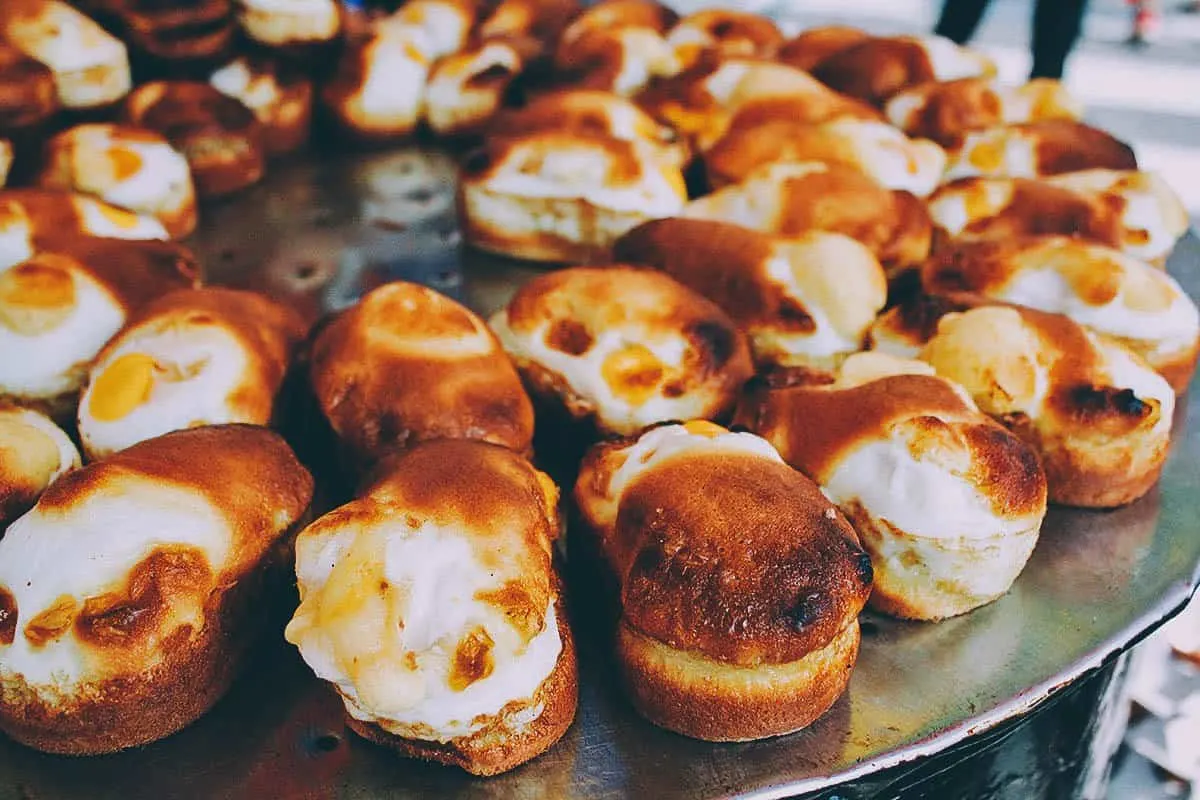
31. Hotteok
Hotteok is a sweet Korean pancake filled with a mixture of brown sugar, honey, chopped peanuts, and cinnamon. It’s believed to have been introduced to Korea by Chinese merchants who immigrated to the country in the late 19th century.
To make, handful-sized balls of stiff dough are filled with this sweet mixture and cooked on a greased griddle. A circular tool is used to press them flat while they cook.
RECIPE: Hotteok
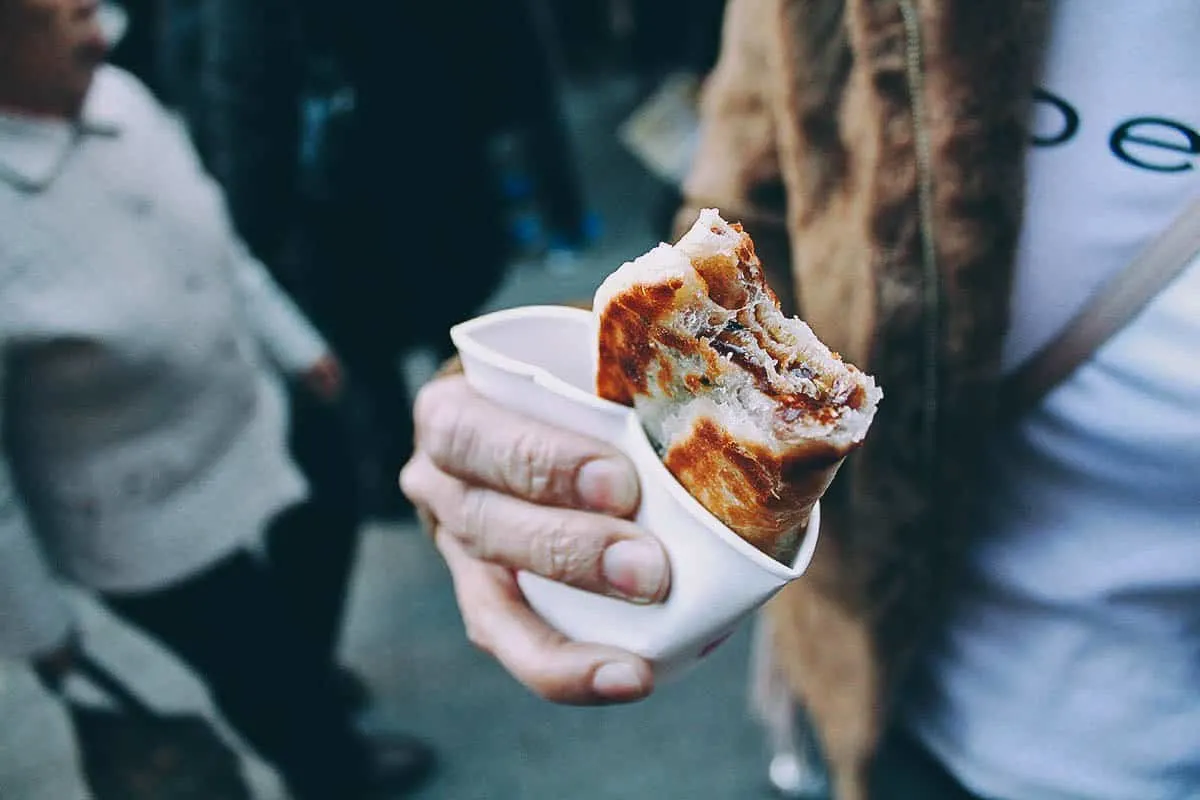
32. Lobster Tails
As you can imagine, these lobster tails topped with melted cheese are among the most expensive types of street food you can find in Korea.
Lobster meat is cut into chunks and blowtorched before being sprinkled on top with shredded cheese. The cheese is melted under a Zaigle (infrared grill) and drizzled with a spicy Korean red chili sauce.
RECIPE: Korean-style grilled lobster tails
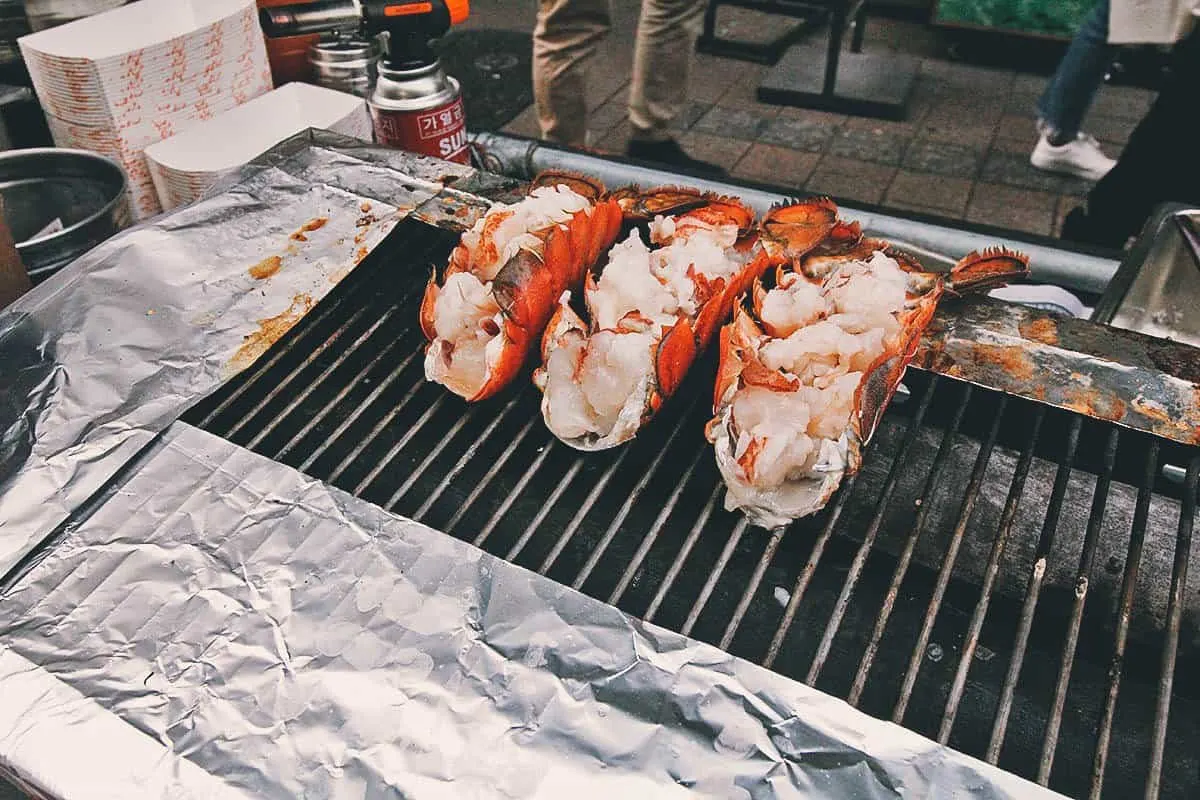
33. Mozzarella & Tteokbokki Skewers
This is a type of kkochi made with grilled pieces of mozzarella and tteokbokki (rice cake). They’re rich, milky, creamy, and chewy. They’re delicious but quite filling.
RECIPE: Cheese-tteok-kkochi
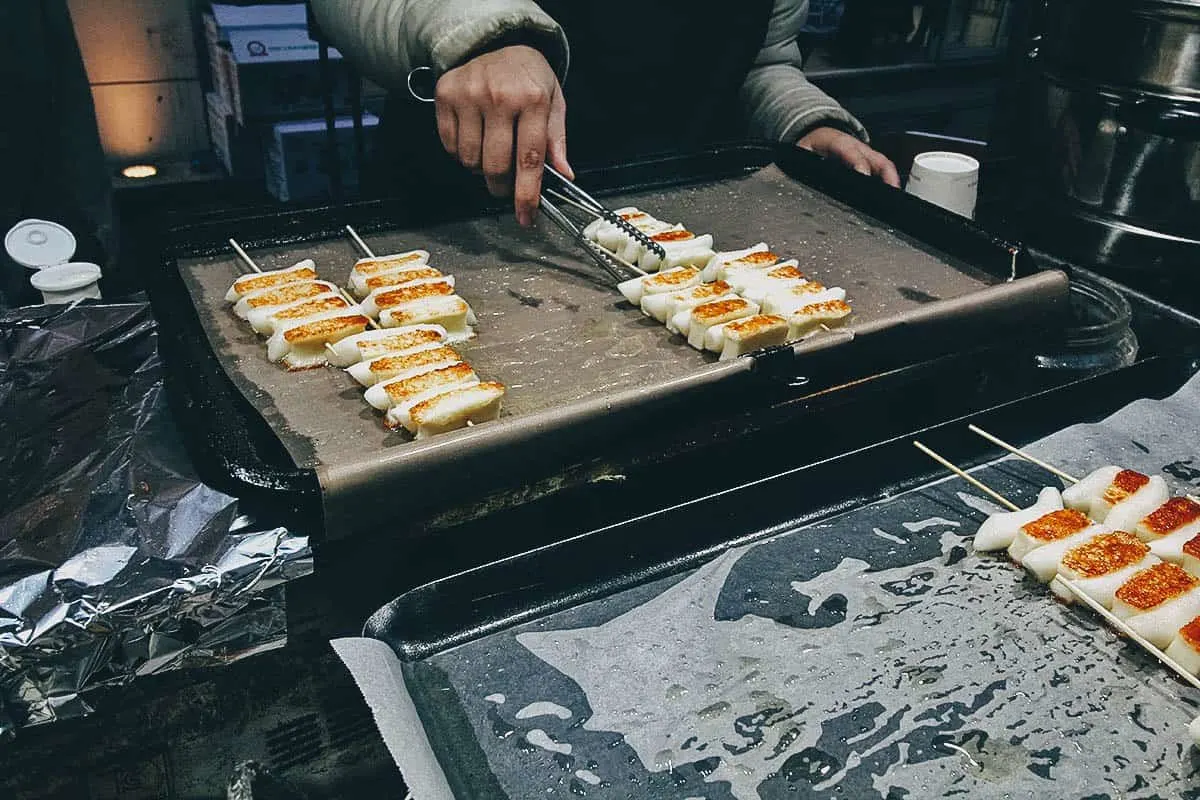
34. Sausage & Tteokbokki Skewers
There are a few variations of these grilled sausage and tteokbokki skewers. Some have beef while others like this one are made with eomuk wrapped around tteokbokki rice cakes.
RECIPE: Sotteok sotteok
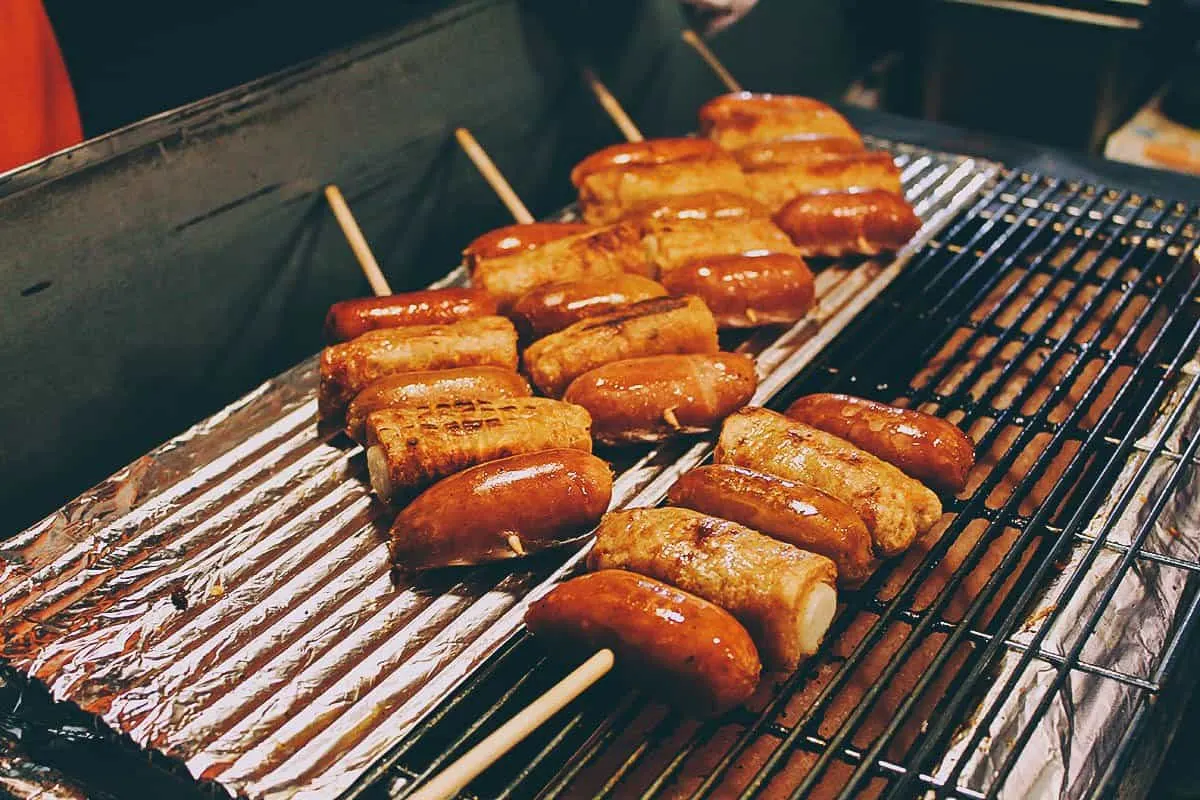
35. Scallops with Butter & Cheese
Like the grilled lobster tails, these torched scallops are on the pricey end of Korean street food dishes. The scallops are drizzled with butter and cheese before being set on fire with a blowtorch.
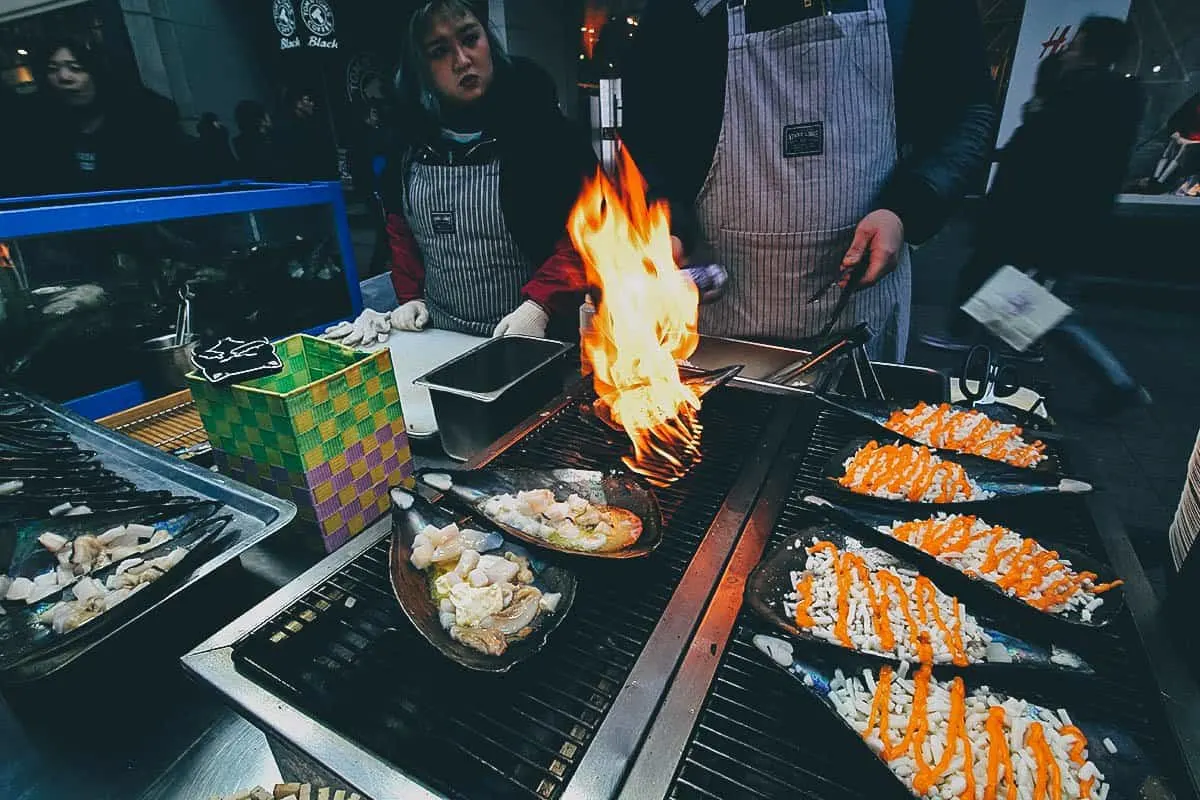
36. Soondae
Soondae is a type of Korean blood sausage. They’re made by boiling or steaming cow’s or pig’s intestines stuffed with various ingredients.
They can be made with seafood like squid or Alaskan pollock but the most common variety is made with pig’s intestines filled with dangmyeon, barley, and pork blood.
It’s a popular snack in both North and South Korea. In the South, they’re typically eaten with the same gochujang-based sauce used with tteokbokki (rice cake).
RECIPE: Sundae-bokkeum
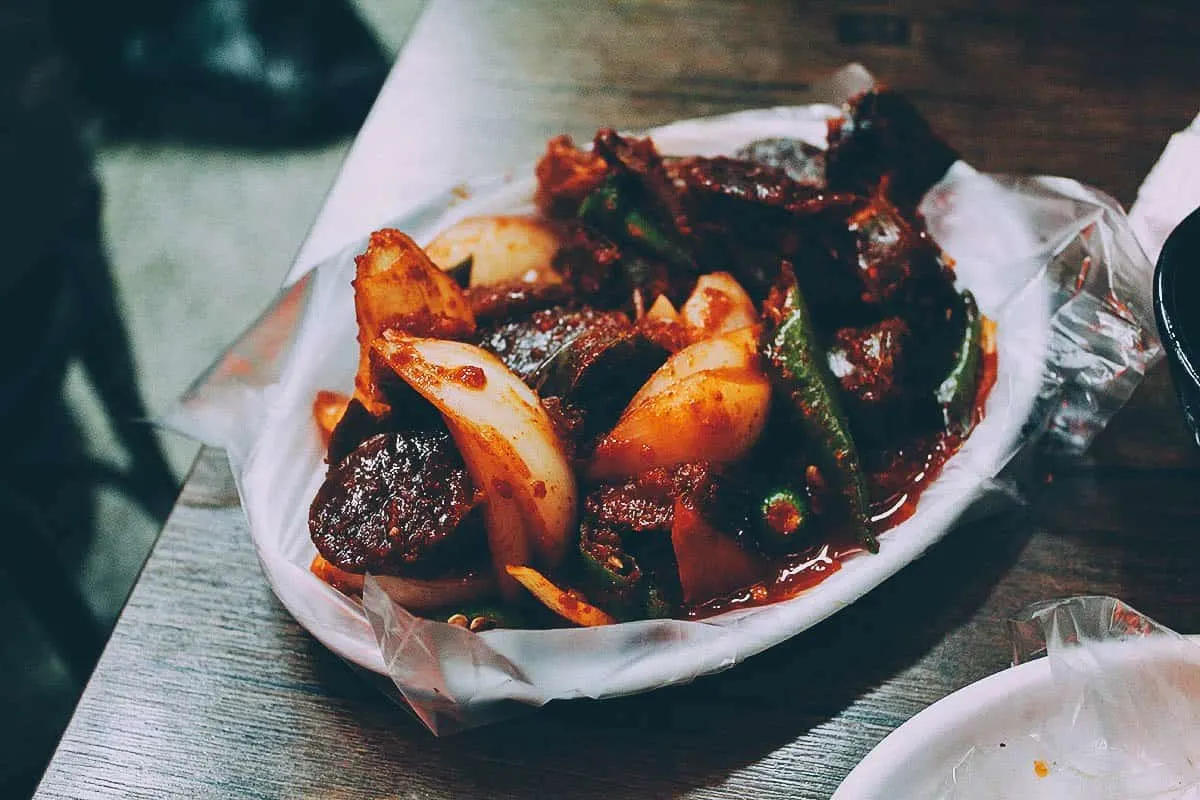
37. Steamed Octopus & Conch
This was another type of kkochi or skewered Korean food often sold in popular tourist areas like Myeongdong and Insadong.
Octopus and conch are cut into bite-sized pieces before being skewered and steamed. They’re typically served with a side of red chili sauce and can be drizzled with bonito flakes.
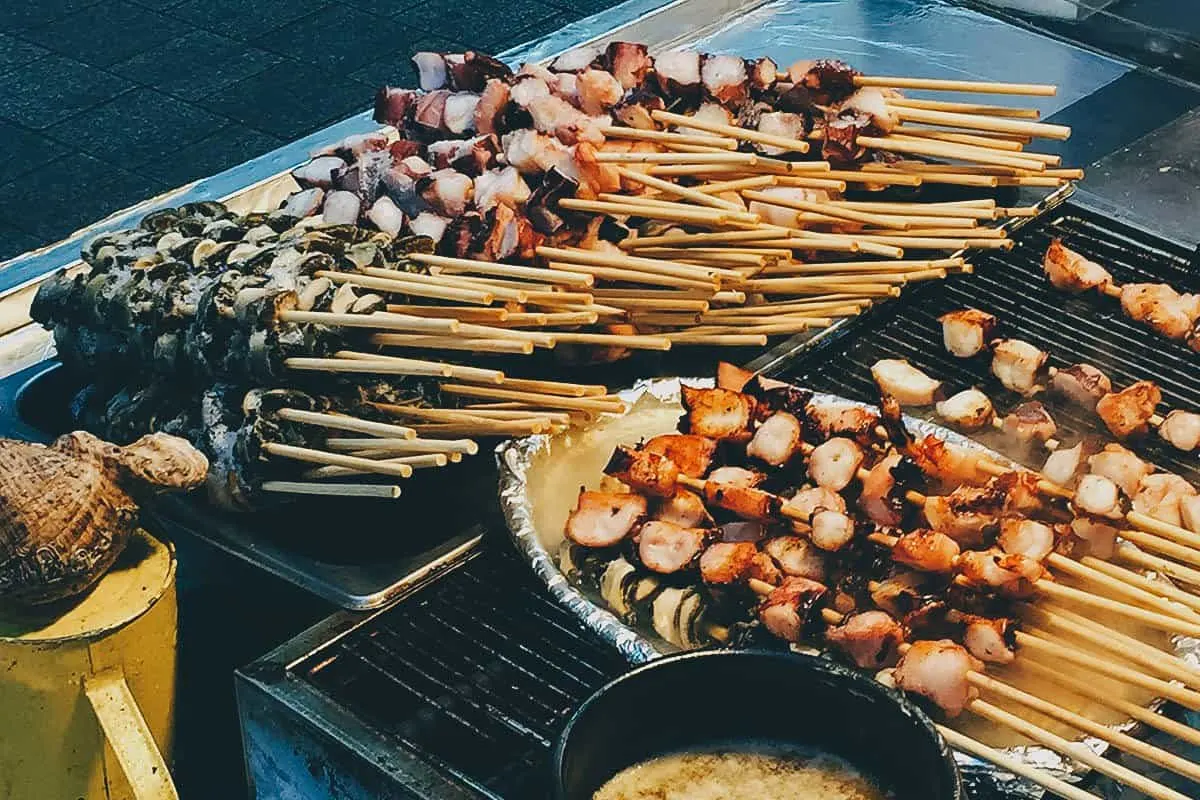
38. Tteokbokki
Tteokbokki is one of the most popular Korean foods. It’s a type of rice cake that can be found pretty much anywhere in Korea – at restaurants, markets, and food stalls, even at some subway stations.
Tteokbokki is made from soft cylindrical-shaped rice cakes mixed with fish cake and drizzled with a spicy gochujang-based sauce or a non-spicy ganjang-based sauce. It’s widely available on its own as street food or mixed with other Korean dishes like fried chicken or jjukumi.
RECIPE: Tteokbokki
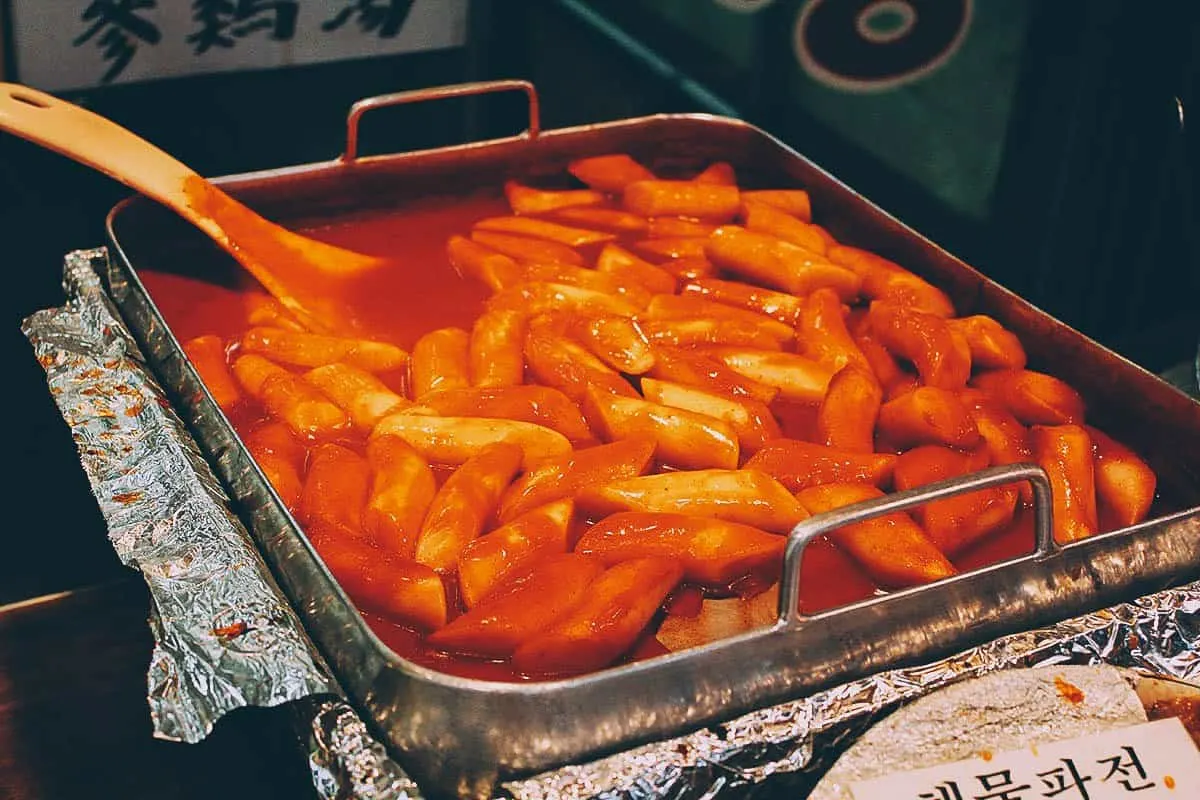
39. Twigim
Twigim is basically Korean-style tempura. It can be made with shrimp, squid, and different types of vegetables.
RECIPE: Twigim
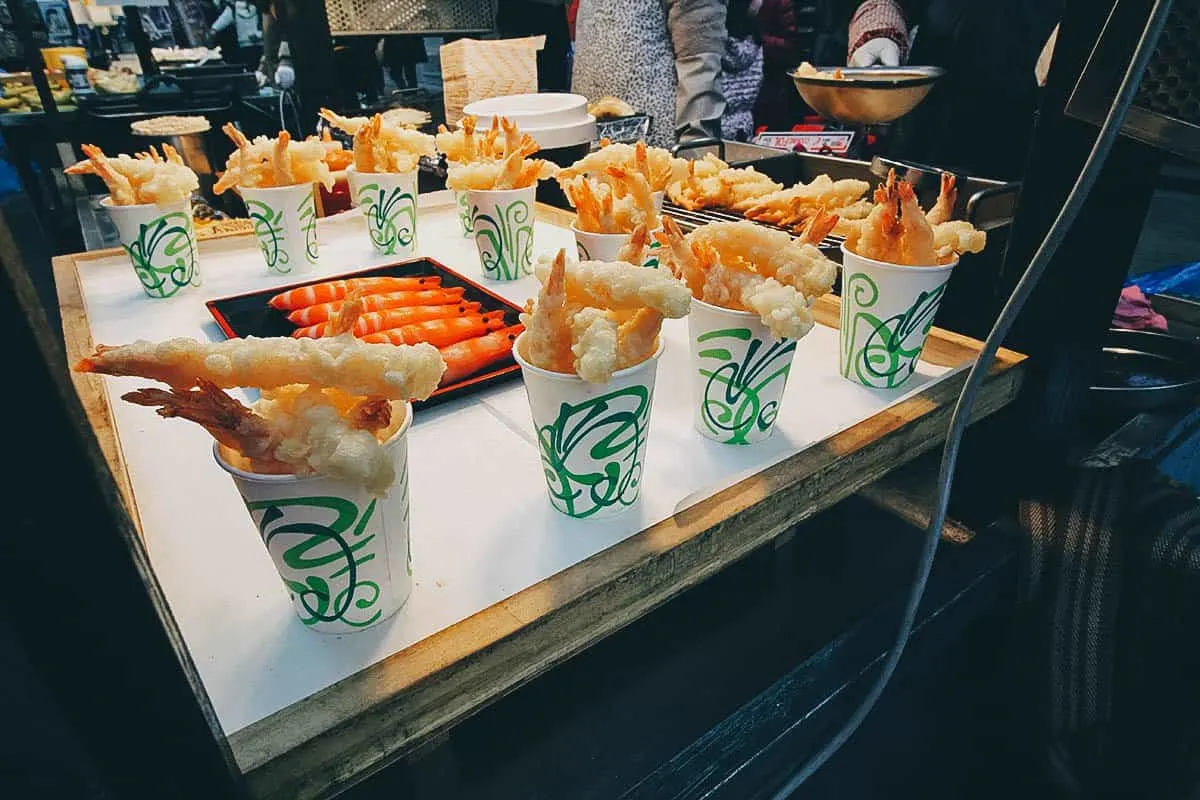
KOREAN TRENDY FOOD
40. Ddongbbang
Shaped like cartoon poop, ddongbbang literally means “poo bread”. It’s a sweet, crisp, and doughy snack filled with a variety of sweet ingredients like warm red bean or chocolate.
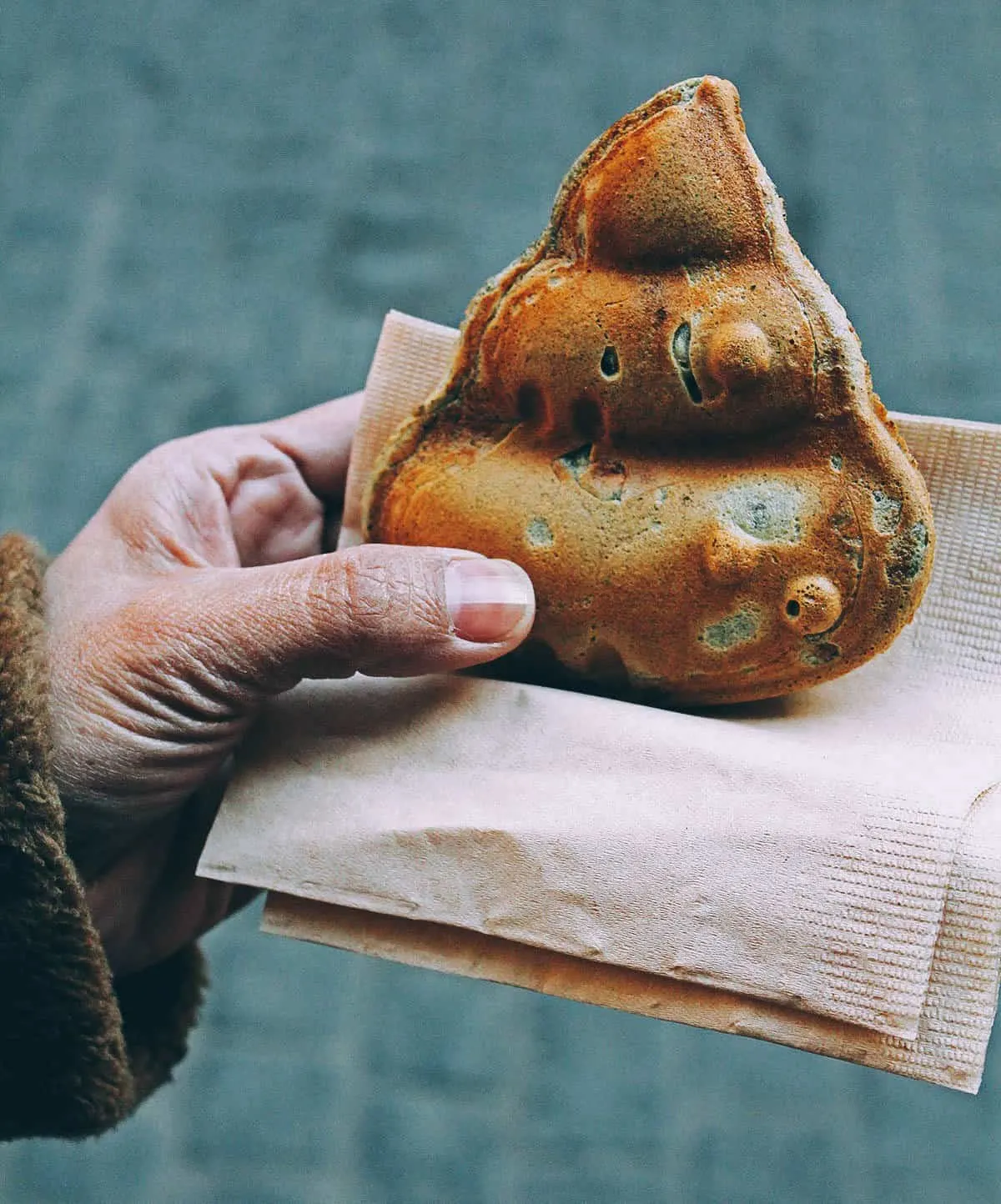
We tried the red bean and it was delicious. It was warm and nutty, just like the real thing. Kidding.
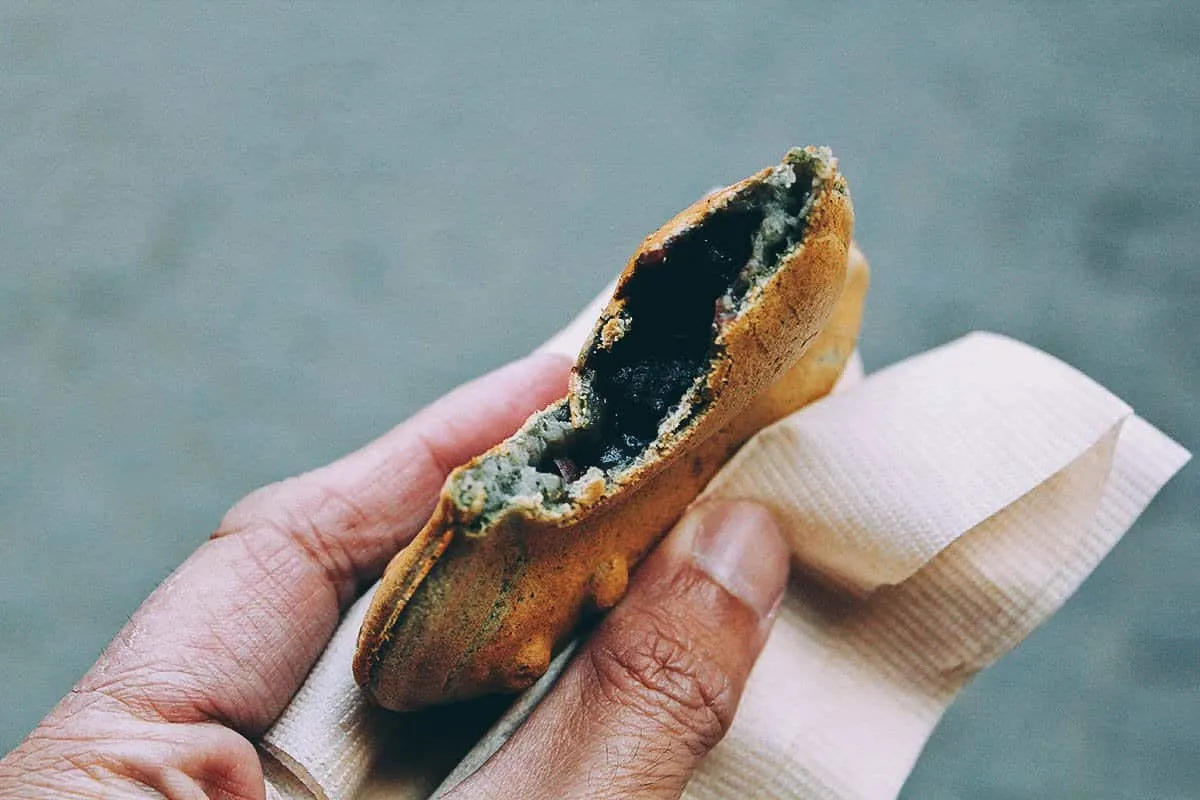
41. Dondurma
I don’t know how this Turkish food became popular in Korea, but you’ll find many of these ice cream stalls in Seoul.
Unlike regular ice cream, Turkish ice cream is made with salep and mastic. Salep is a flour made from the root of the early purple orchid while mastic is a resin that gives the ice cream its characteristic chewiness. The result is a stickier ice cream that doesn’t melt as quickly.
Dondurma is available in multiple flavors and typically served in a cone, but you can find it in other forms as well like this macaron ice cream sandwich.
RECIPE: Turkish dondurma
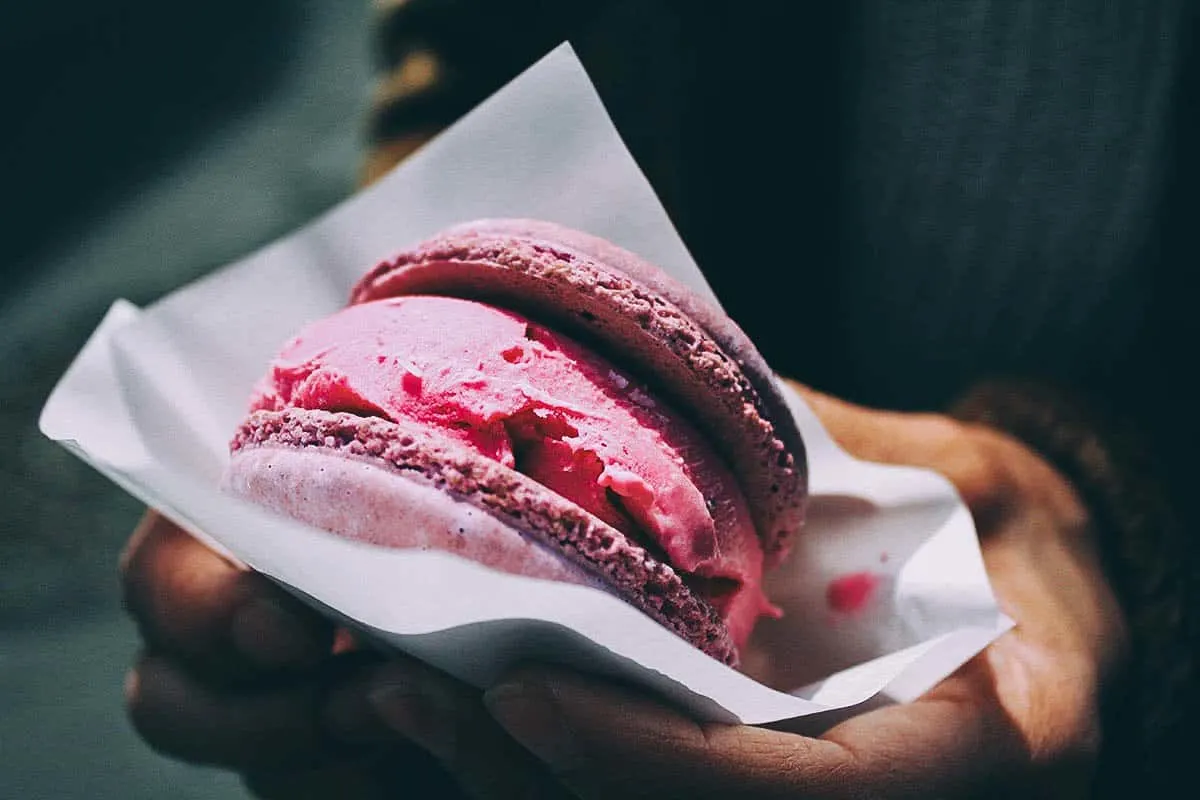
42. Jipangyi Cane Ice Cream
Jipangyi cane ice cream refers to a Korean dessert or snack that’s part ice cream cone, part sex toy. This long and phallic j-shaped hollow cone is made with puffed rice or corn and filled with soft serve gelato ice cream.
Jipangyi means “cane” in Korean, hence the shape. It’s a popular snack sold in many tourist areas like Insadong.
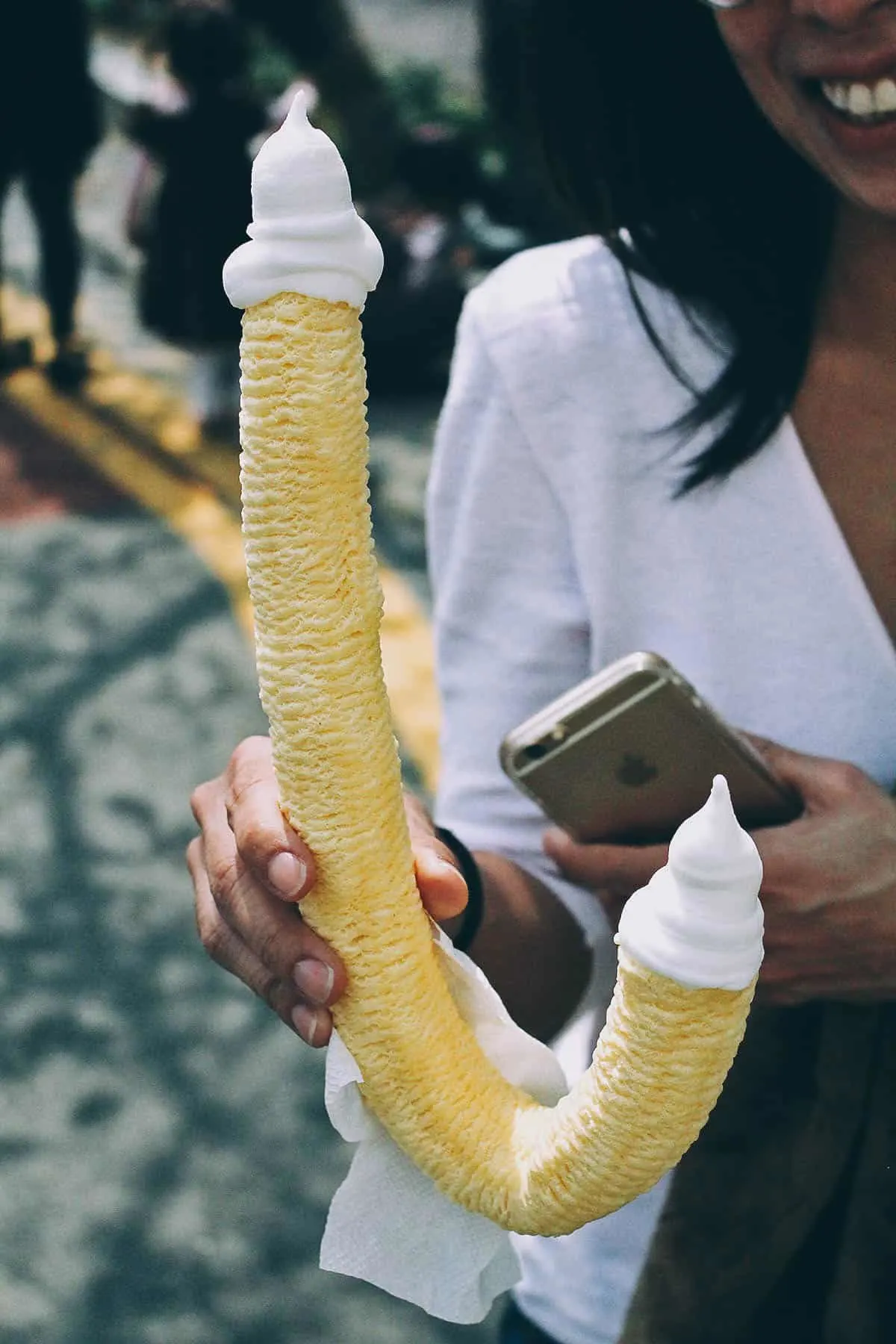
43. Schnee Pang
Like dondurma, schnee pang is a foreign snack that’s become popular in Korea. Originally from Germany where it’s called a schneeball, it’s made by cutting strips of rolled out shortcrust dough and arranging them into balls. The ball is then deep-fried and dusted with confectioner’s sugar or coated with other toppings.
Before serving, they put the ball into a paper bag and smash it into bite-sized pieces with a hammer. The cookie comes in many flavors and has a crunchy texture similar to Chinese-American fortune cookies.
RECIPE: German schneeball
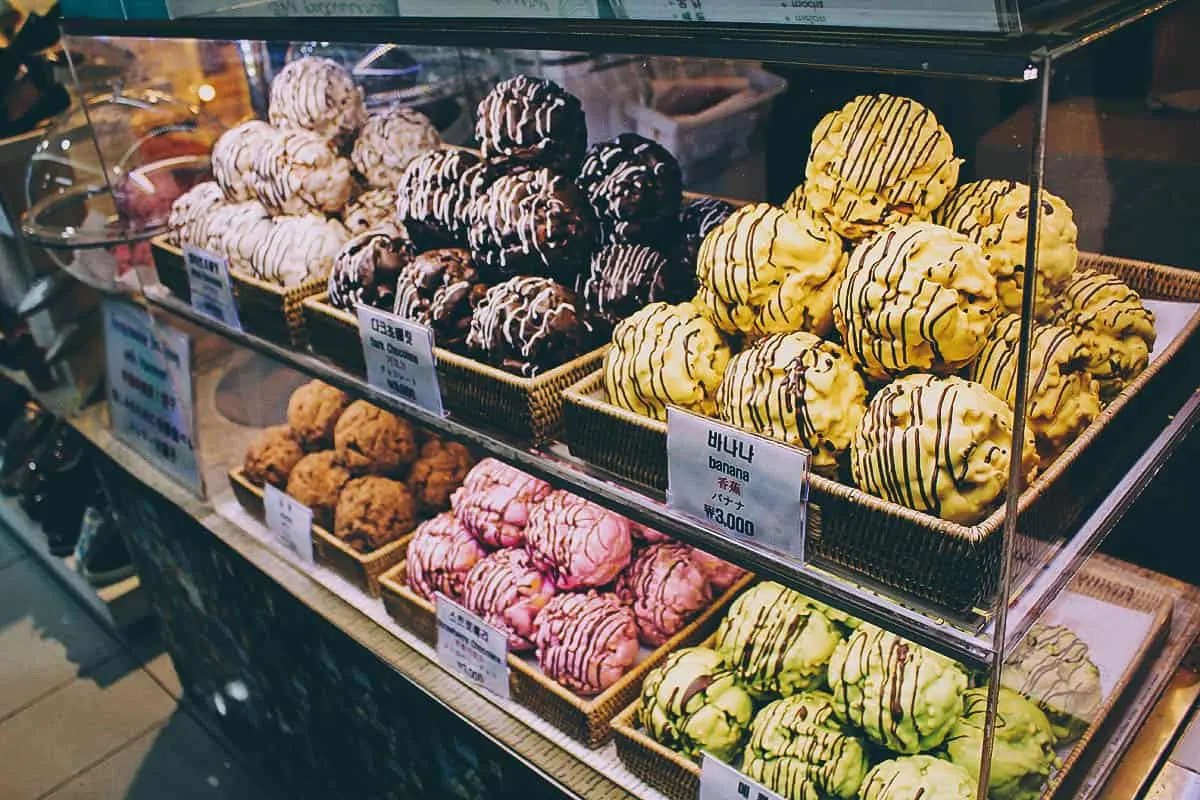
44. Gamja Hot Dog
A gamja hot dog is basically a corn dog coated in chopped up french fries. It’s typically served with mayonnaise, chili sauce, or mustard.
RECIPE: Gamja hot dog
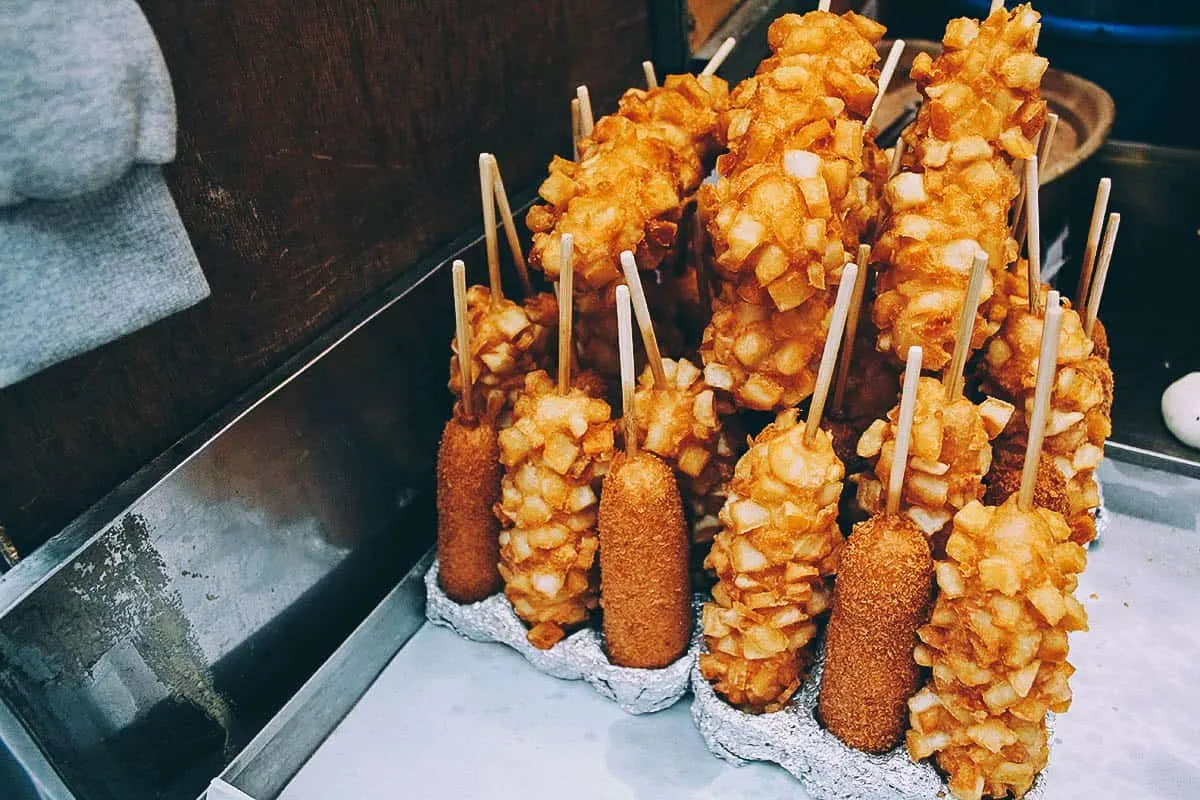
45. Tornado Potato
This corkscrew-like snack is another popular Korean snack. You can think of it as a cross between french fries and potato chips. Some versions even have a hot dog running through the center of the potato spiral.
RECIPE: Korean tornado potato
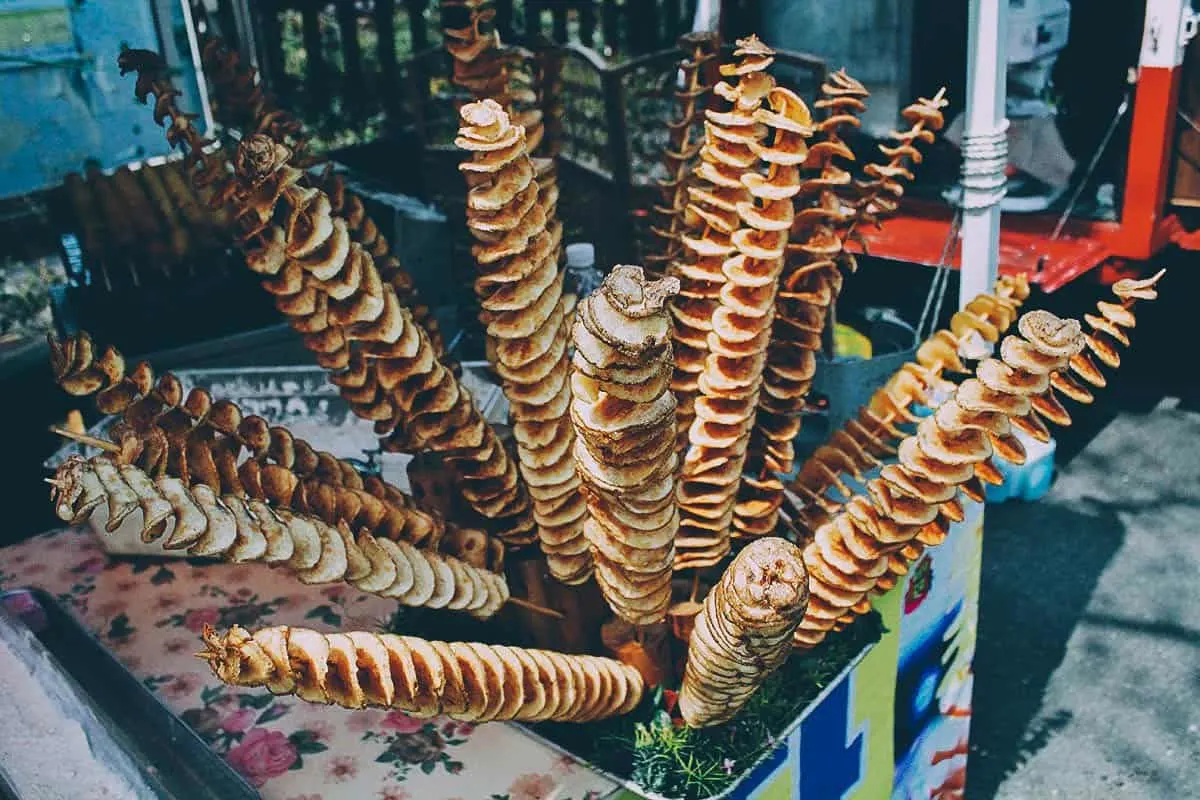
SOUTH KOREAN FOOD TOURS
Needless to say, no one knows Korean food better than a local, so what better way to experience the best of the cuisine than by going on a food tour? Not only will a food-obsessed guide take you to the city’s best restaurants, markets, and food stalls, but they’ll be able to explain all the Korean dishes to you in more detail. Check out Get Your Guide for a list of Korean food tours in Seoul and in other cities in South Korea.
SOUTH KOREAN COOKING CLASSES
Eating the best Korean food is one thing, but learning how to make it is another. In our opinion, taking a cooking class is one of the best ways to learn about a foreign cuisine. If you’re fond of cooking and want to learn more about Korean food and recipes, then check out Cookly for a list of cooking classes in South Korea.
FINAL THOUGHTS ON KOREAN FOOD
The first version of this South Korean food guide consisted of twenty Korean foods. Over four years and three trips later, it’s more than doubled to 45.
Needless to say, this is a list I plan on updating and expanding with every return trip to Korea. With so much yet to experience, we want to explore other cities and regions in South Korea to further our knowledge of Korean food.
Now that you know WHAT you should eat in Korea, find out WHERE you should try them by checking out our guide on the best restaurants in Seoul.
Thanks for reading and have a delicious time exploring the cuisine of South Korea!
Disclosure
Some of the links in this South Korean food guide are affiliate links. If you make a booking or rservation, then we’ll earn a small commission at no additional cost to you. As always, we only recommend products and services that we use ourselves and firmly believe in. We really appreciate your support as it helps us make more of these free travel and food guides. Thank you!


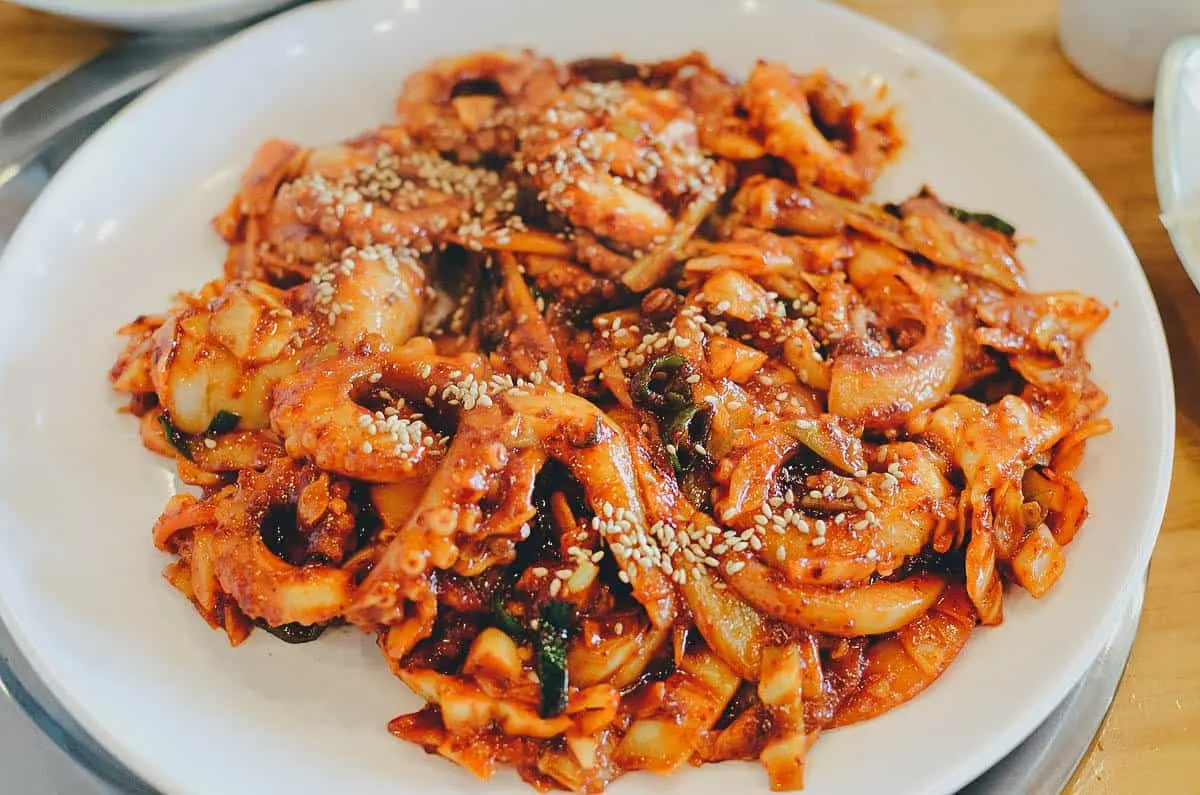
rei
Monday 17th of October 2022
When did you start your food blog? Btw thanks for the korean food recommendations
Yolanda Owens
Thursday 18th of August 2022
I watch the very best food review show and I see all these on the show thanks for sharing 🙌🏾💯
JB & Renée
Saturday 20th of August 2022
Happy you appreciated it Yolanda!
Mike
Friday 27th of August 2021
Some of the trendy foods I have never seen before, and I come to Seoul almost every year...
I would put Tokkebi Hot Dog in just the Street Food section, not trendy. It's been around a while and will probably stay. I spent a year of elementary school in Seoul in the 1980s and they had those...
JB & Renée
Tuesday 7th of September 2021
Thank for the suggestion Mike! I'll make that change when it's time to update the post.
Tom Adams
Friday 23rd of July 2021
Galbi???
JB & Renée
Friday 23rd of July 2021
@Tom Adams: What about it???
martin
Saturday 19th of June 2021
Lovely article! This all looks so good. South Korea is high up on my travel bucket list. I want to try all of the dishes listed. I've become more and more interested in South Korean food, culture, and history since getting hooked on Kdrams!
JB & Renée
Thursday 24th of June 2021
Hi Martin, those Kdramas certainly do a good job of highlighting and promoting Korean food!